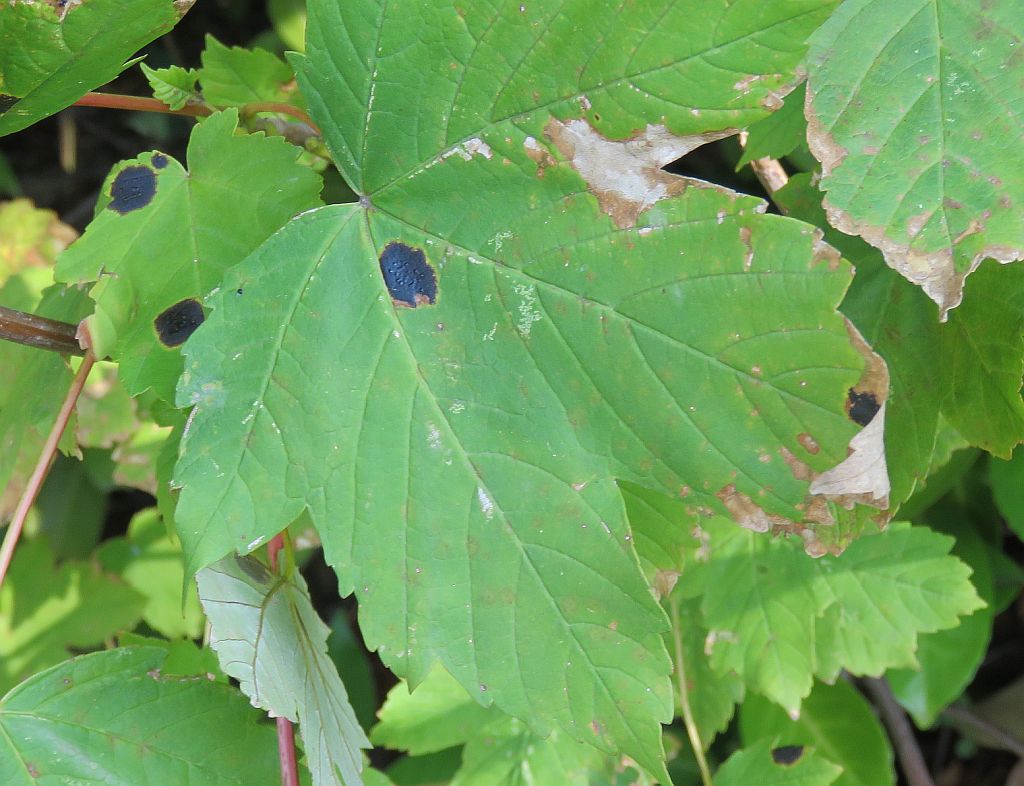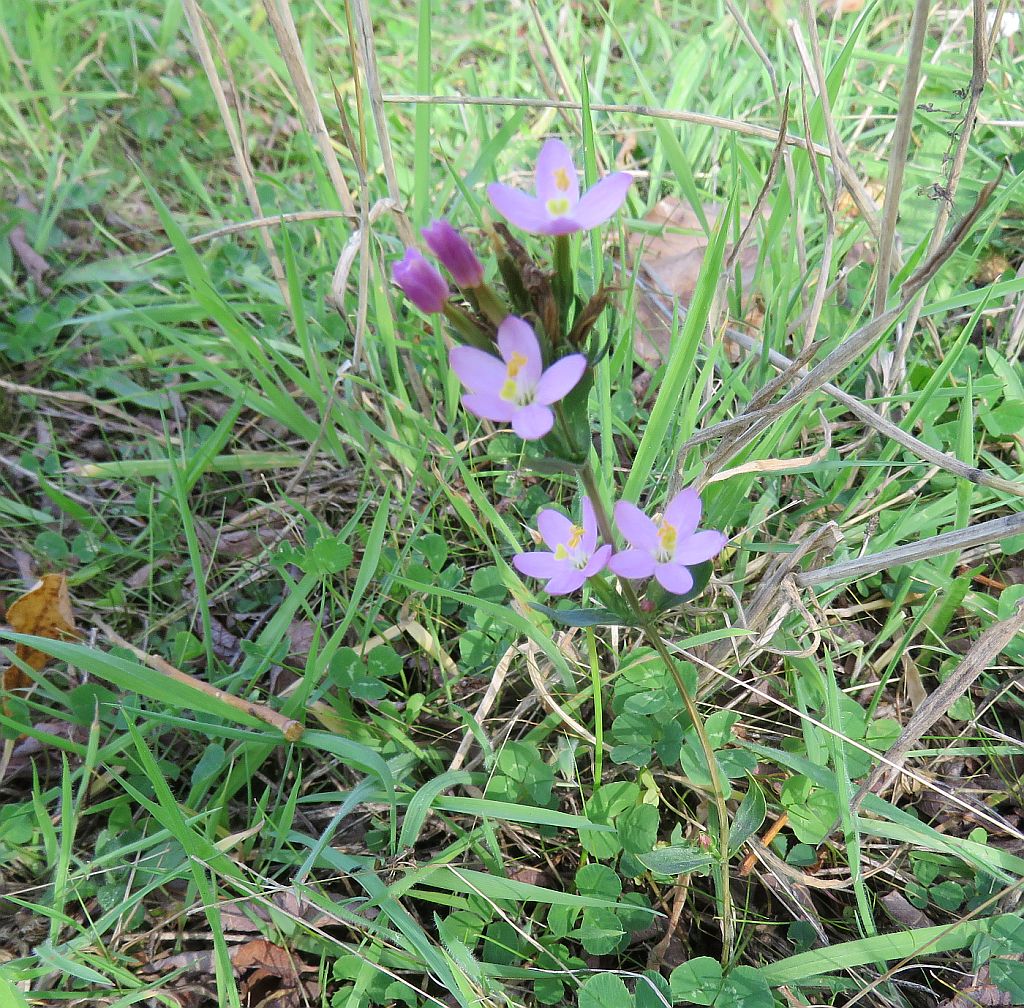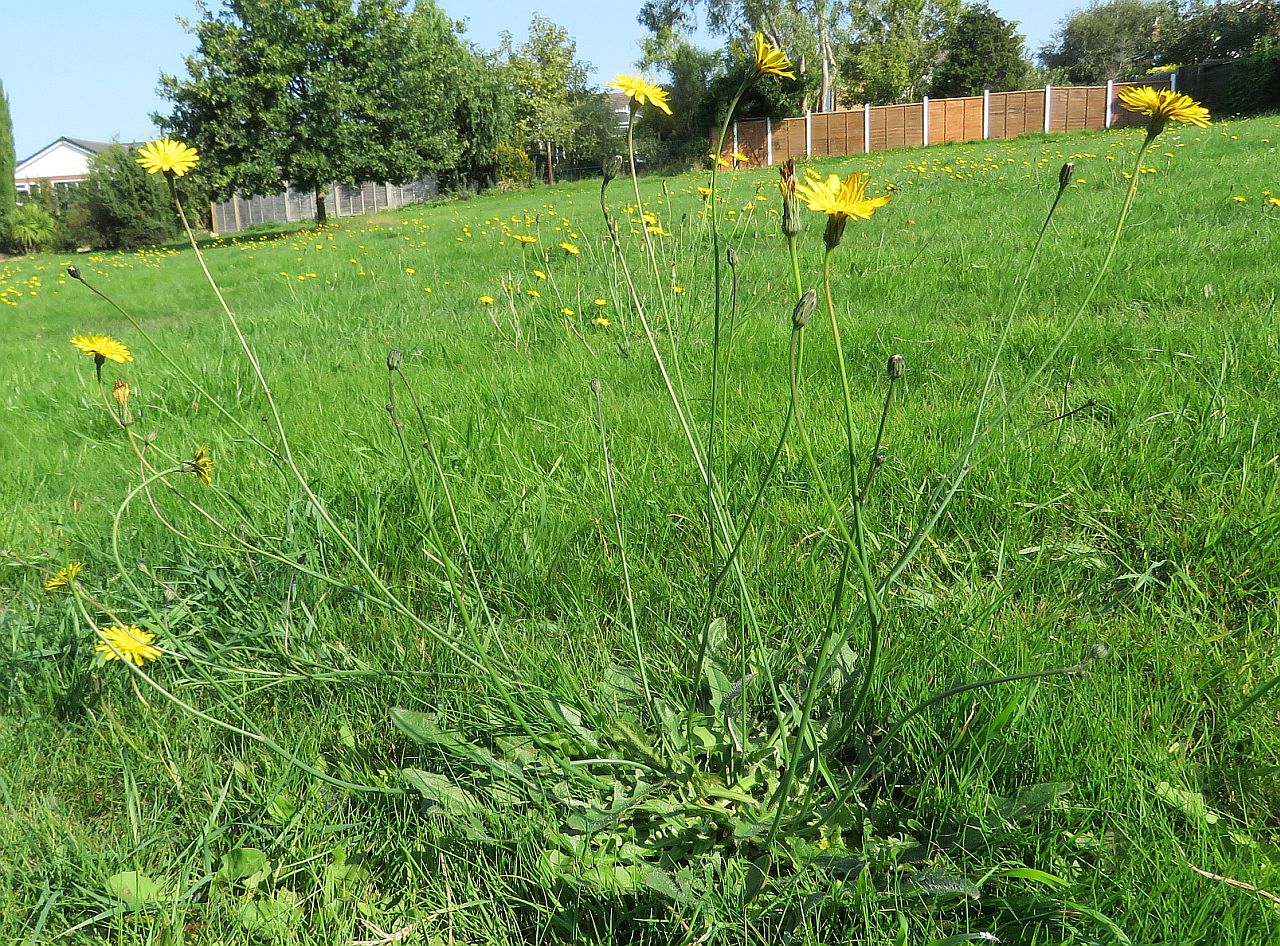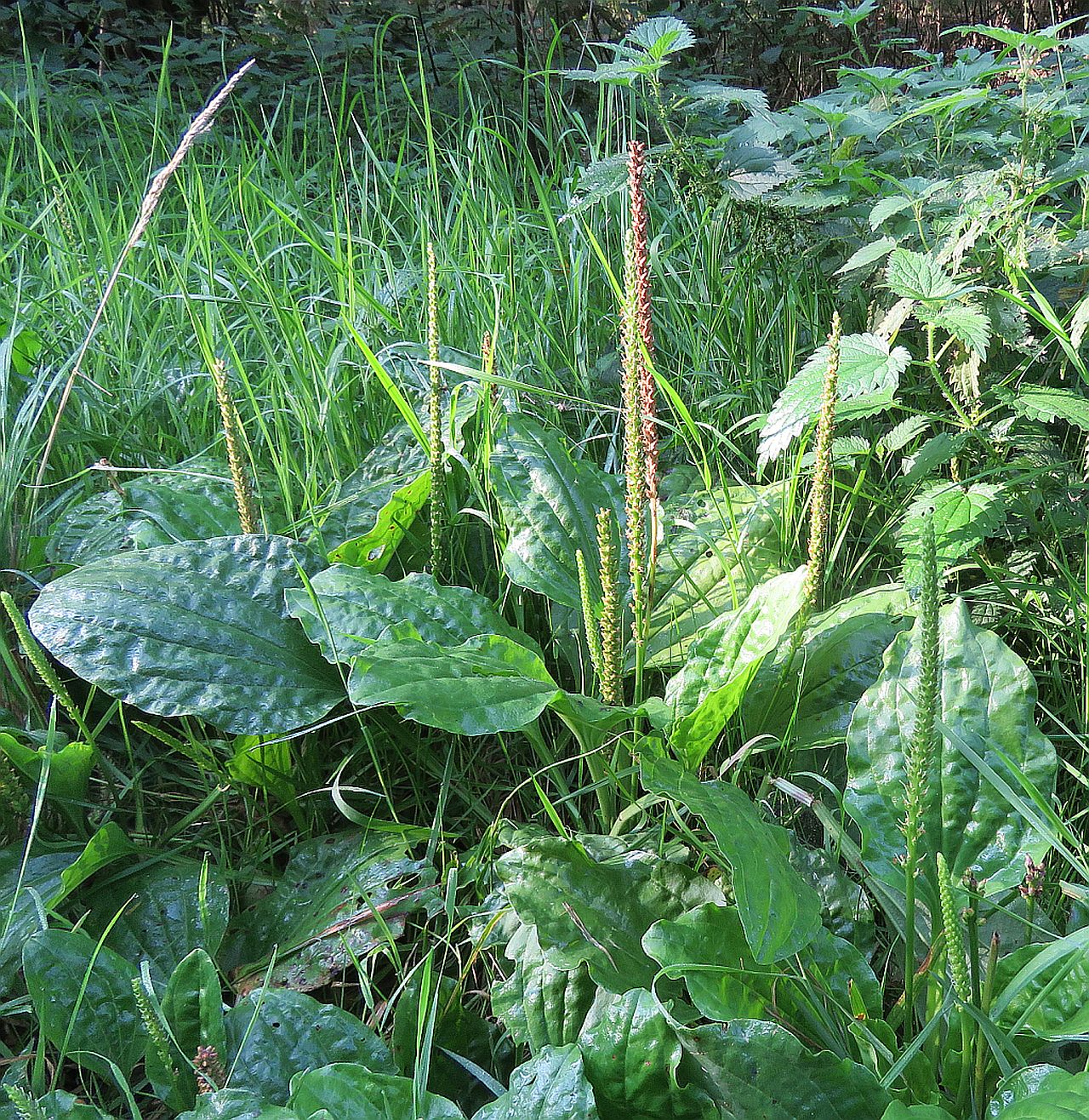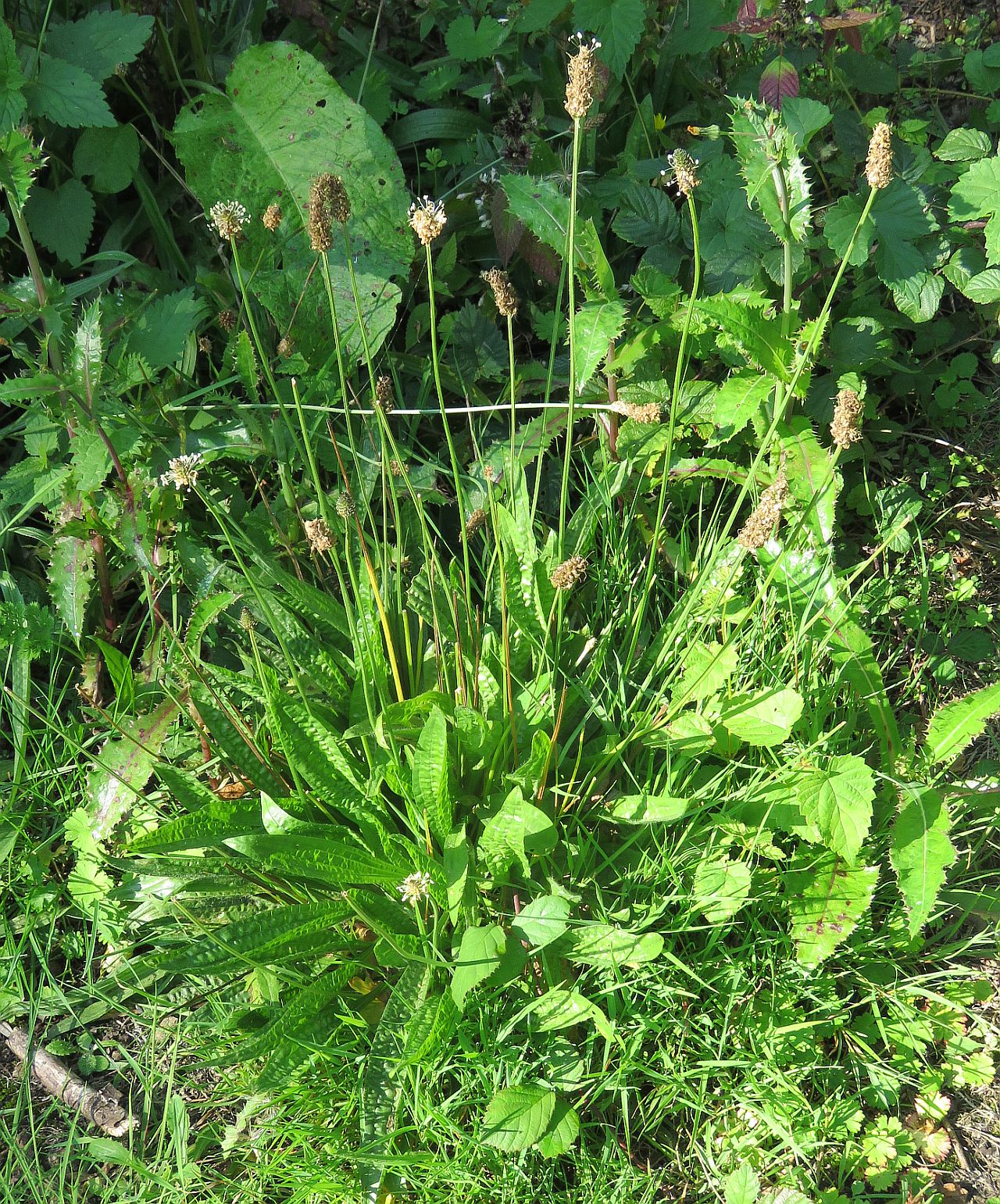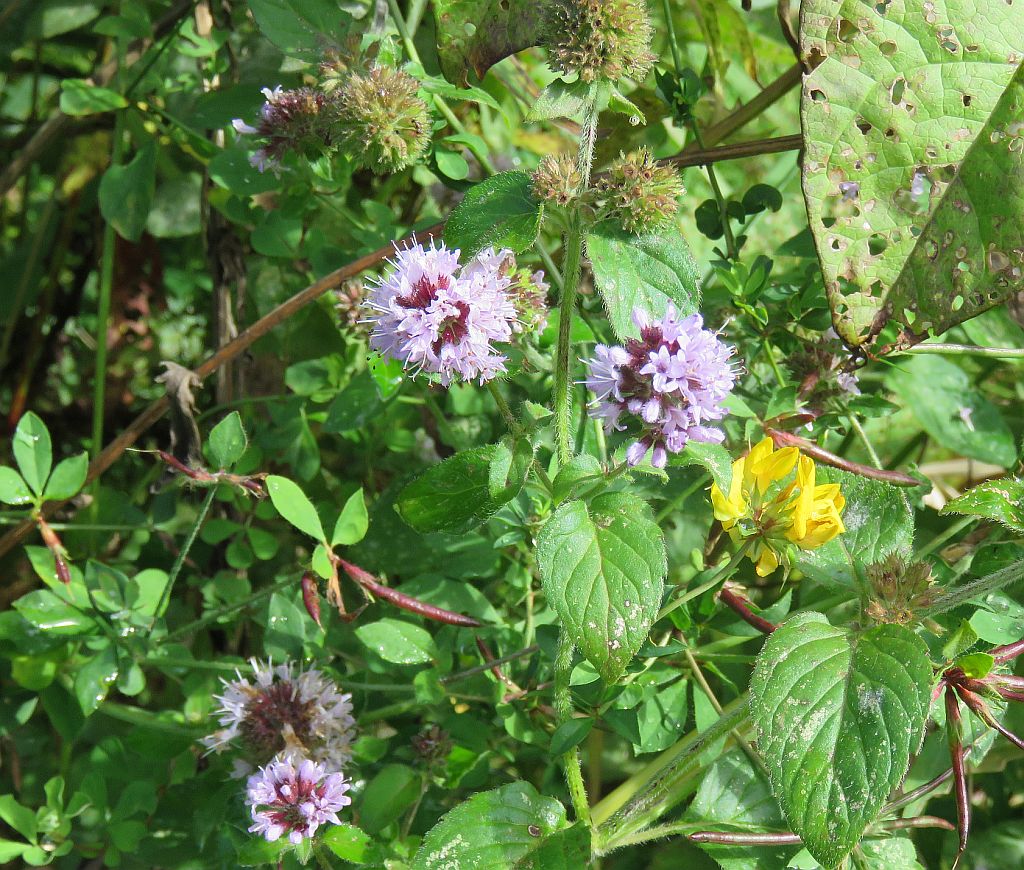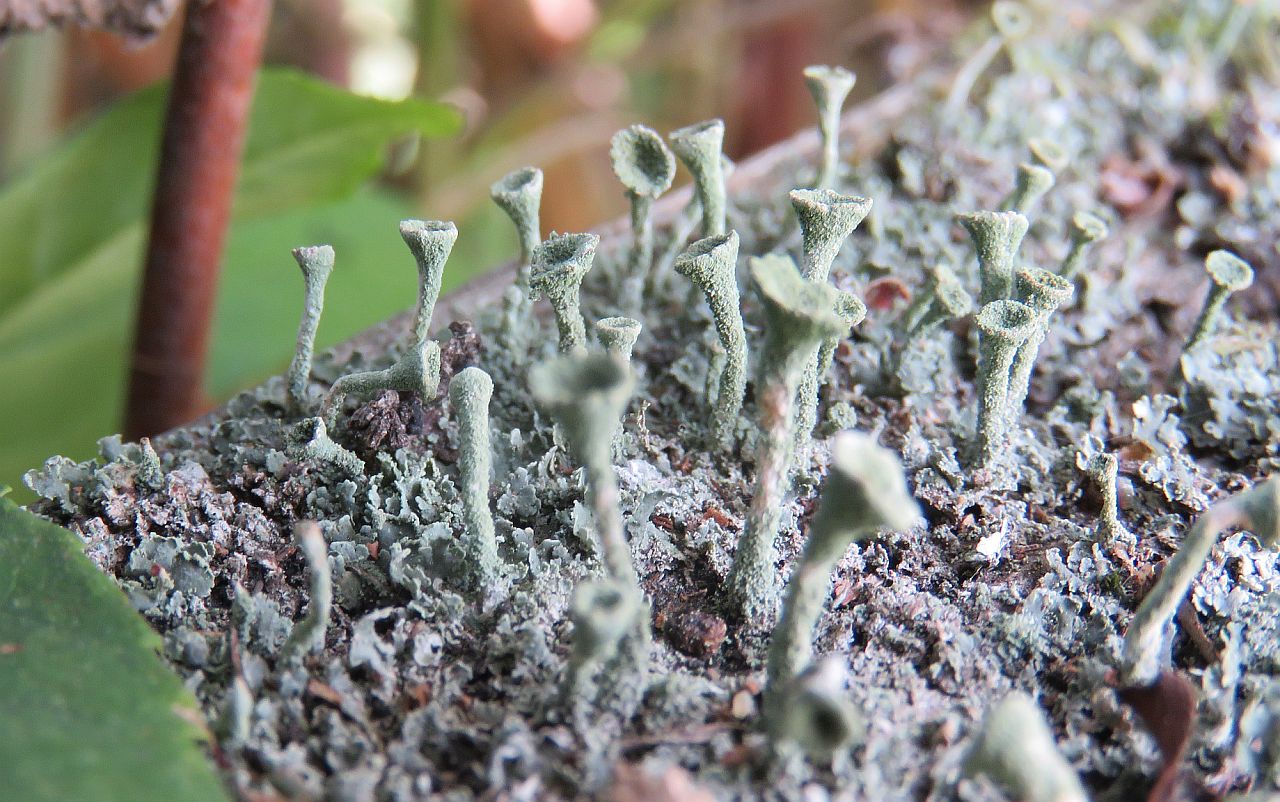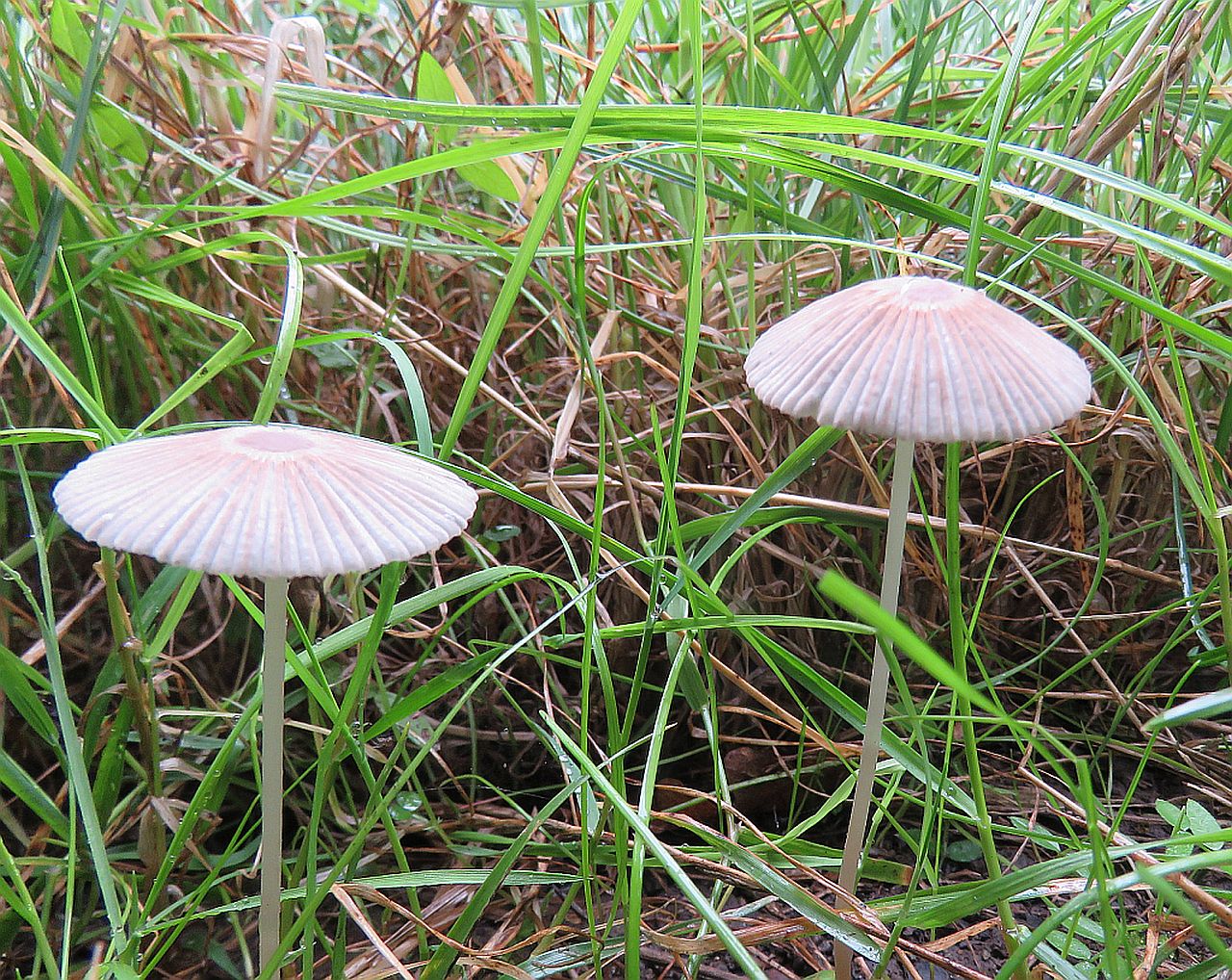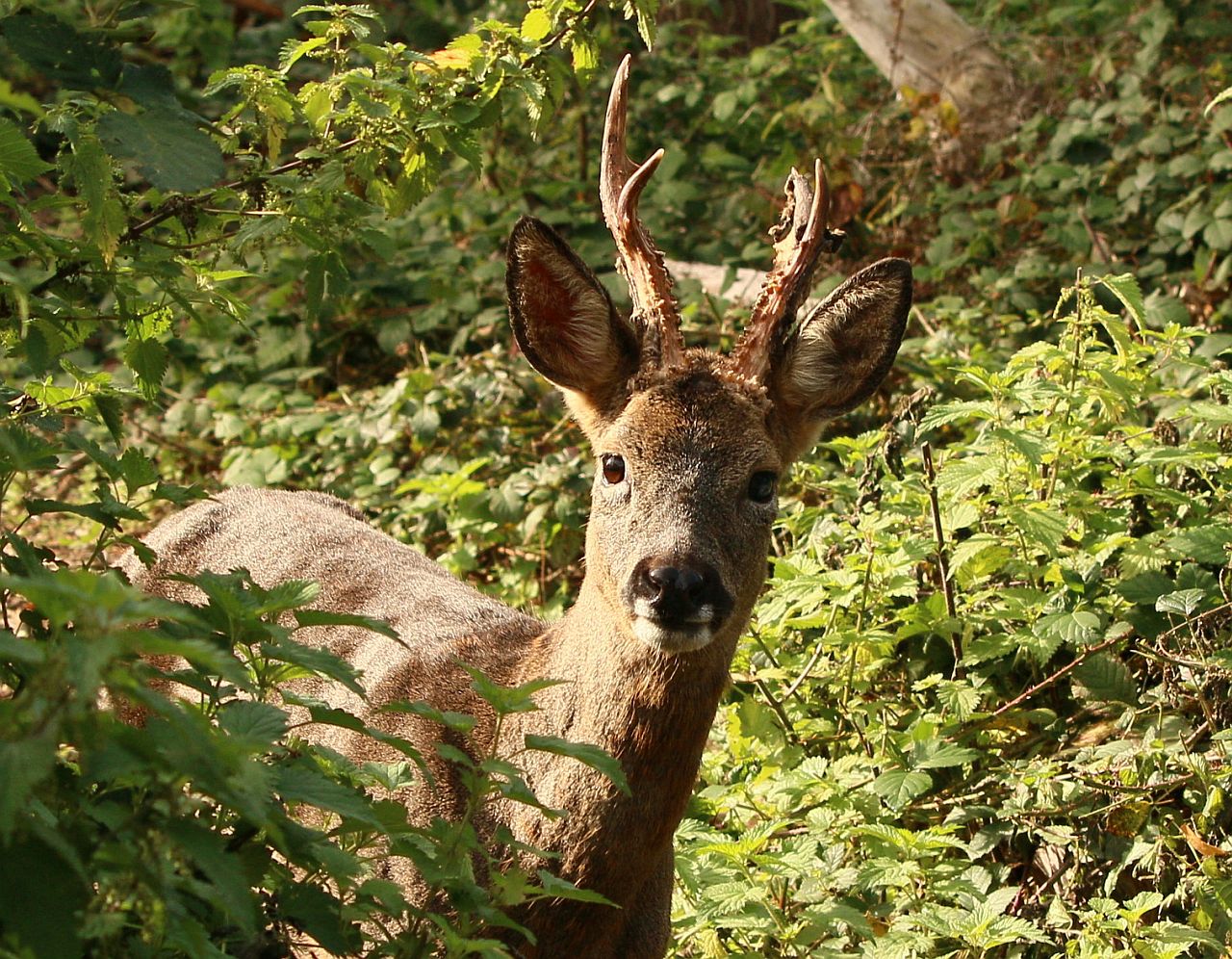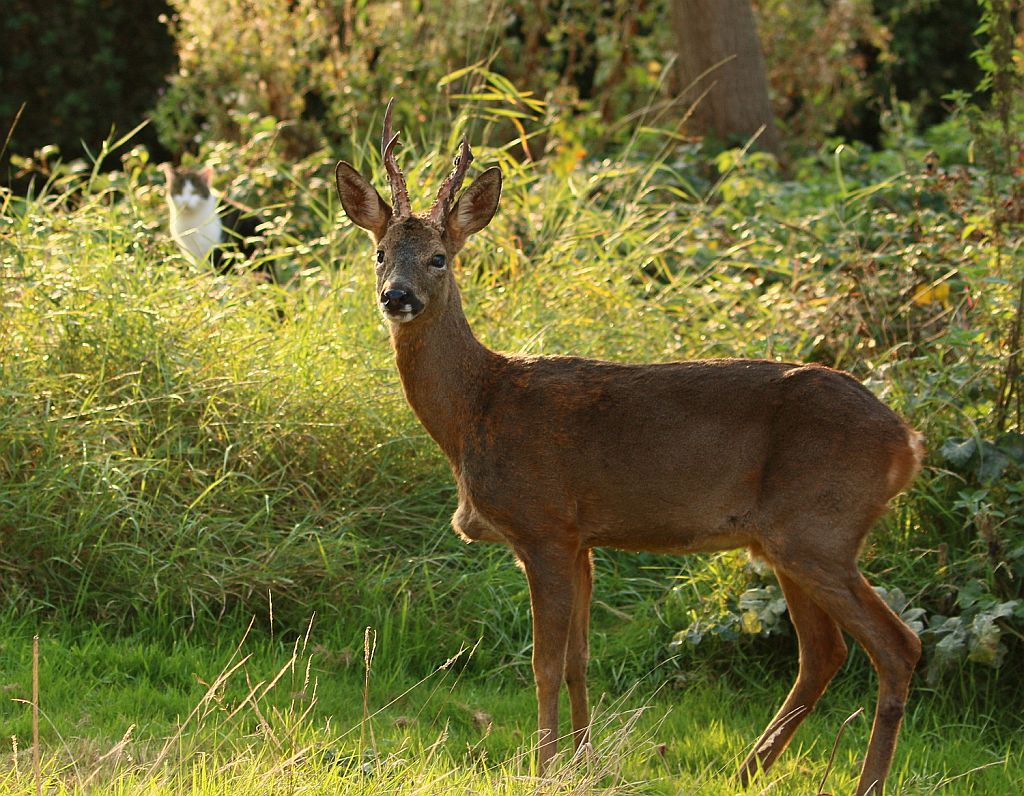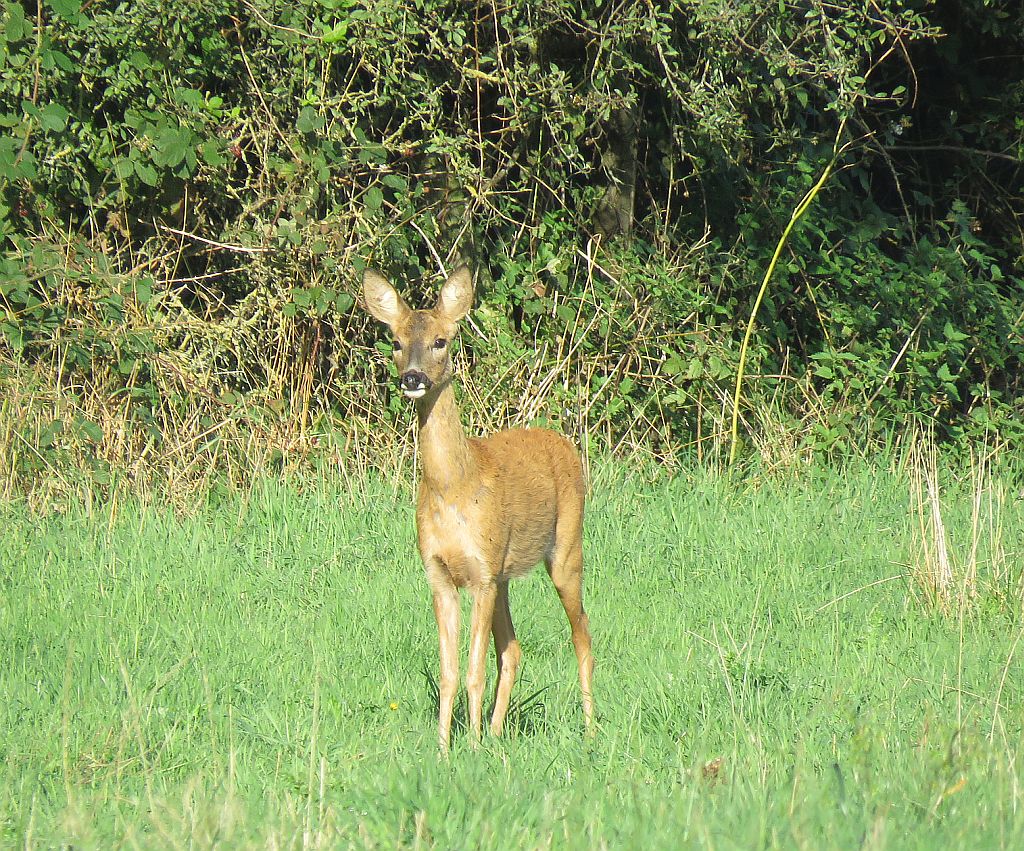Insects
29/09/20
 In Area 7A a Hornet Vespa crabro and a Small White Pieris rapae were seen in Copse Wood. In the sunshine a Comma Polygonia c-album was enjoying an Area 4 garden.
In Area 7A a Hornet Vespa crabro and a Small White Pieris rapae were seen in Copse Wood. In the sunshine a Comma Polygonia c-album was enjoying an Area 4 garden.
27/09/20
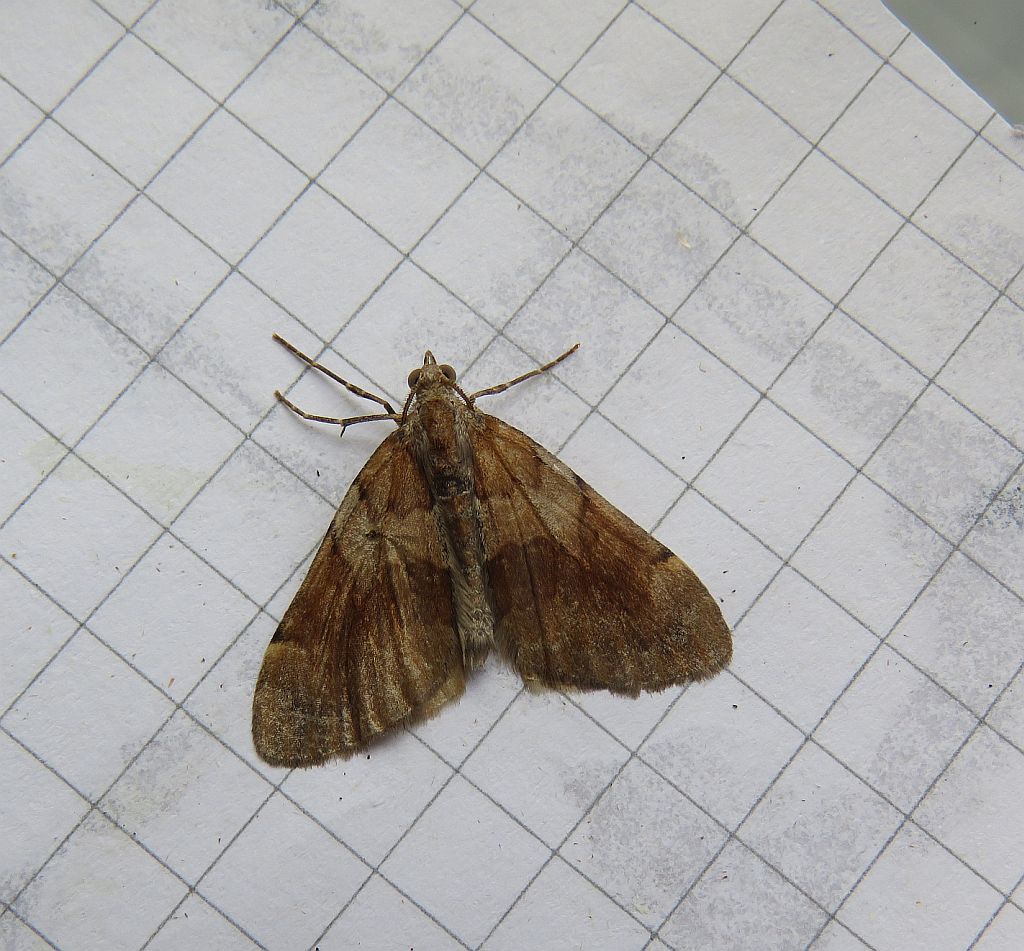 With the overnight temperature just in double figures the Moth trap was out overnight in Area 7A and emptied this morning .30 moths of 12 species were in the trap. Highlights included Pine Carpet Pennithera firmata , 10 Lunar Underwing Omphaloscelis lunosa and 2 Angle Shades Phlogophora meticulosa Following inspection and recording/photographing anything caught is released. A male Common Darter Sympetrum striolatum was seen in a brief bit of sunshine in Area 10.
With the overnight temperature just in double figures the Moth trap was out overnight in Area 7A and emptied this morning .30 moths of 12 species were in the trap. Highlights included Pine Carpet Pennithera firmata , 10 Lunar Underwing Omphaloscelis lunosa and 2 Angle Shades Phlogophora meticulosa Following inspection and recording/photographing anything caught is released. A male Common Darter Sympetrum striolatum was seen in a brief bit of sunshine in Area 10.
26/09/20
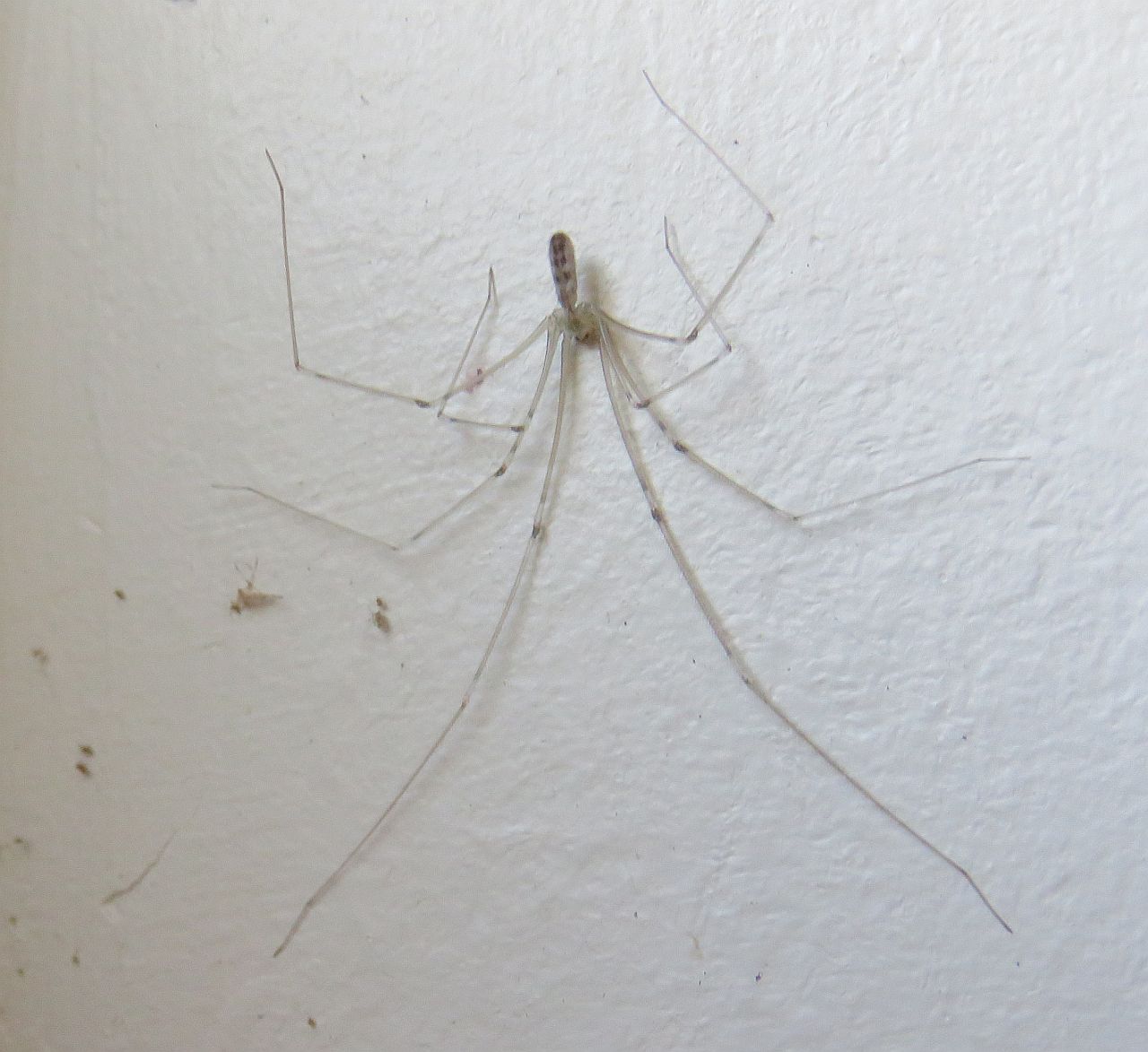 Seen in Area 7A was the Daddy longlegs Spider Pholcus phalangioides . It is relatively easy to identify due to the very long legs and cylindrical body. Pholcus phalangioides is an eight-eyed spider, which is a pale brown except for a gray patch in the center of the cephalothorax. The body and legs are almost translucent.
Seen in Area 7A was the Daddy longlegs Spider Pholcus phalangioides . It is relatively easy to identify due to the very long legs and cylindrical body. Pholcus phalangioides is an eight-eyed spider, which is a pale brown except for a gray patch in the center of the cephalothorax. The body and legs are almost translucent.
22/09/20
 On a gloomy afternoon in Area 7 the only thing of interest was the Fly Nowickia ferox .
On a gloomy afternoon in Area 7 the only thing of interest was the Fly Nowickia ferox .
20/09/20
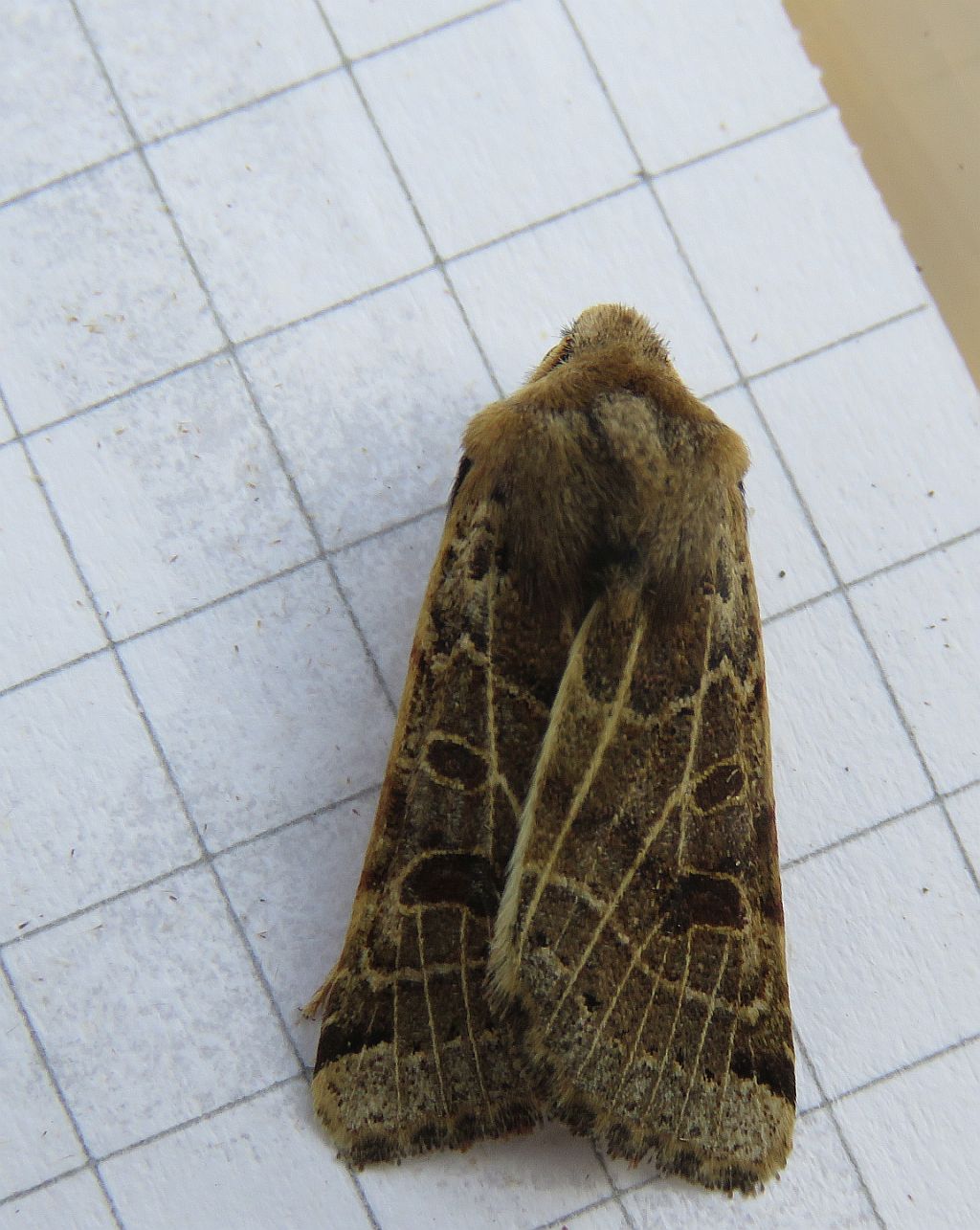 With another mild and dry night forecast the Moth trap was out overnight and emptied this morning in Area 7A. 45 moths of 20 species were in the trap . Highlights were Lunar Underwing Omphaloscelis lunosa , Sallow Cirrhia icteritia
With another mild and dry night forecast the Moth trap was out overnight and emptied this morning in Area 7A. 45 moths of 20 species were in the trap . Highlights were Lunar Underwing Omphaloscelis lunosa , Sallow Cirrhia icteritia 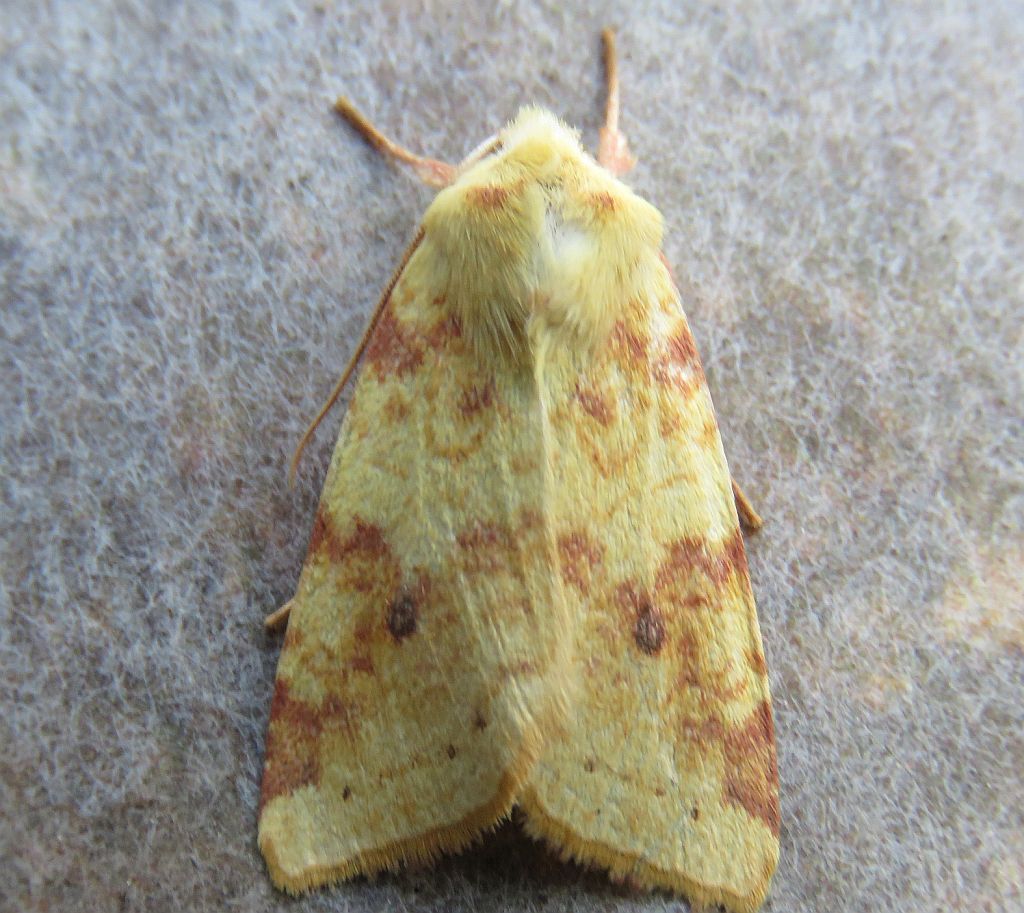 and Dusky Thorn Ennomos fuscantaria
and Dusky Thorn Ennomos fuscantaria 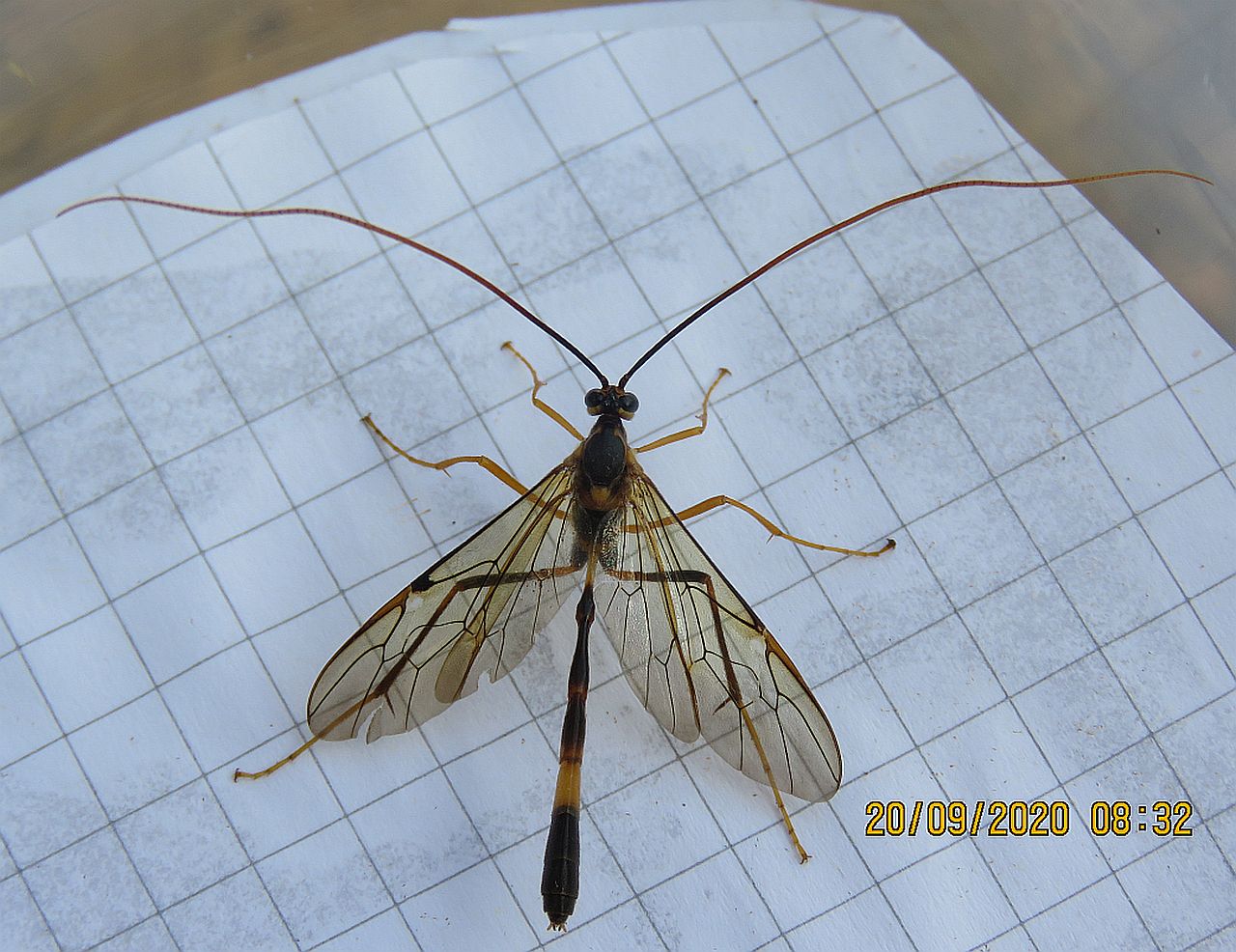 Also caught was the striking, large ichneumon wasp Stauropoctonus bombycivorus and 2 Red legged Shieldbug Eurygaster testudinaria . Following inspection and recording/photographing anything caught is released.In Area 10 this afternoon in the Car Park field
Also caught was the striking, large ichneumon wasp Stauropoctonus bombycivorus and 2 Red legged Shieldbug Eurygaster testudinaria . Following inspection and recording/photographing anything caught is released.In Area 10 this afternoon in the Car Park field
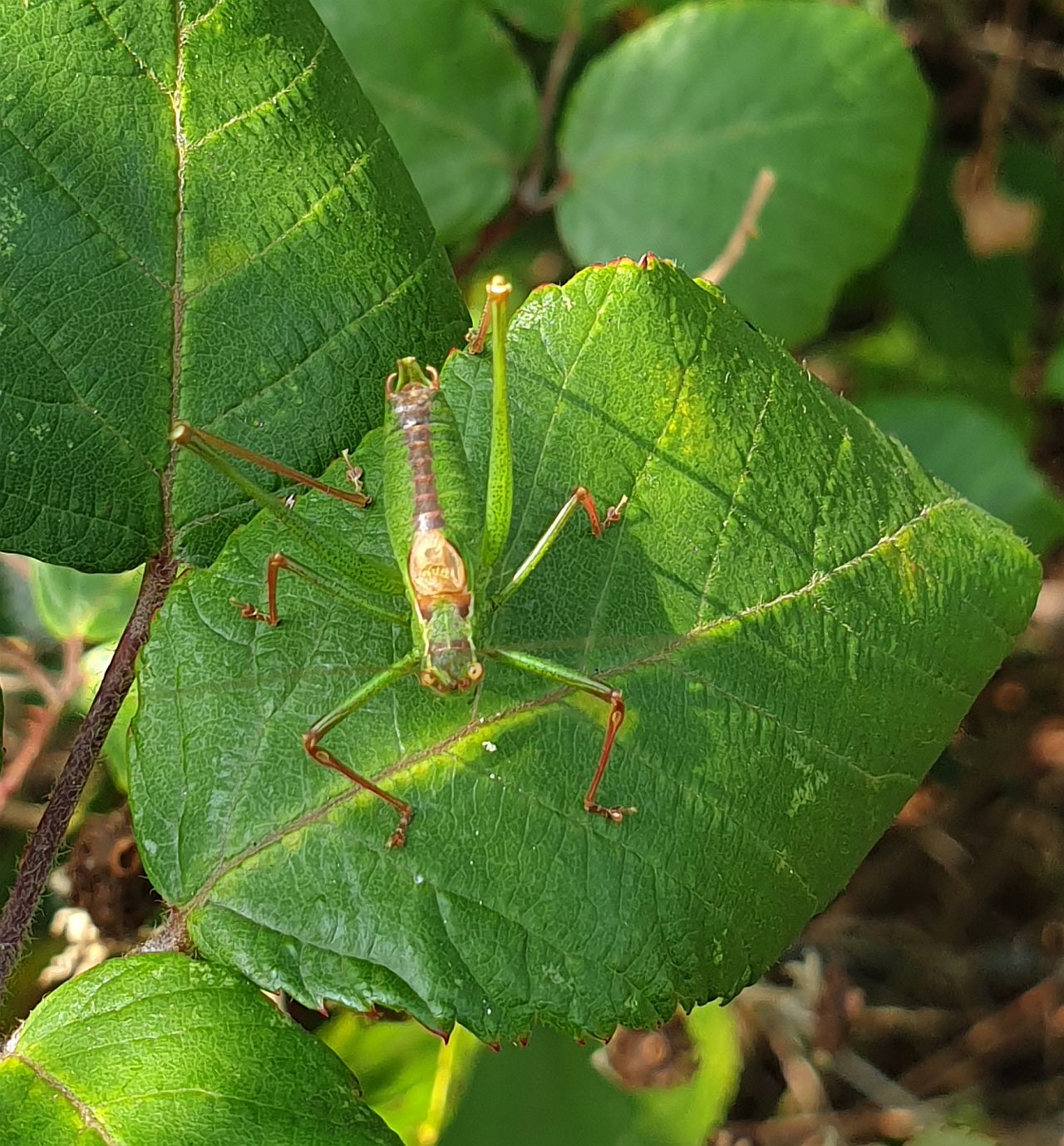 was a Male Speckled Bush Cricket Omphaloscelis lunosa . As the name suggests, the green body is covered in tiny black spots, it also has a pale brown stripe down its back.
was a Male Speckled Bush Cricket Omphaloscelis lunosa . As the name suggests, the green body is covered in tiny black spots, it also has a pale brown stripe down its back.
19/09/20
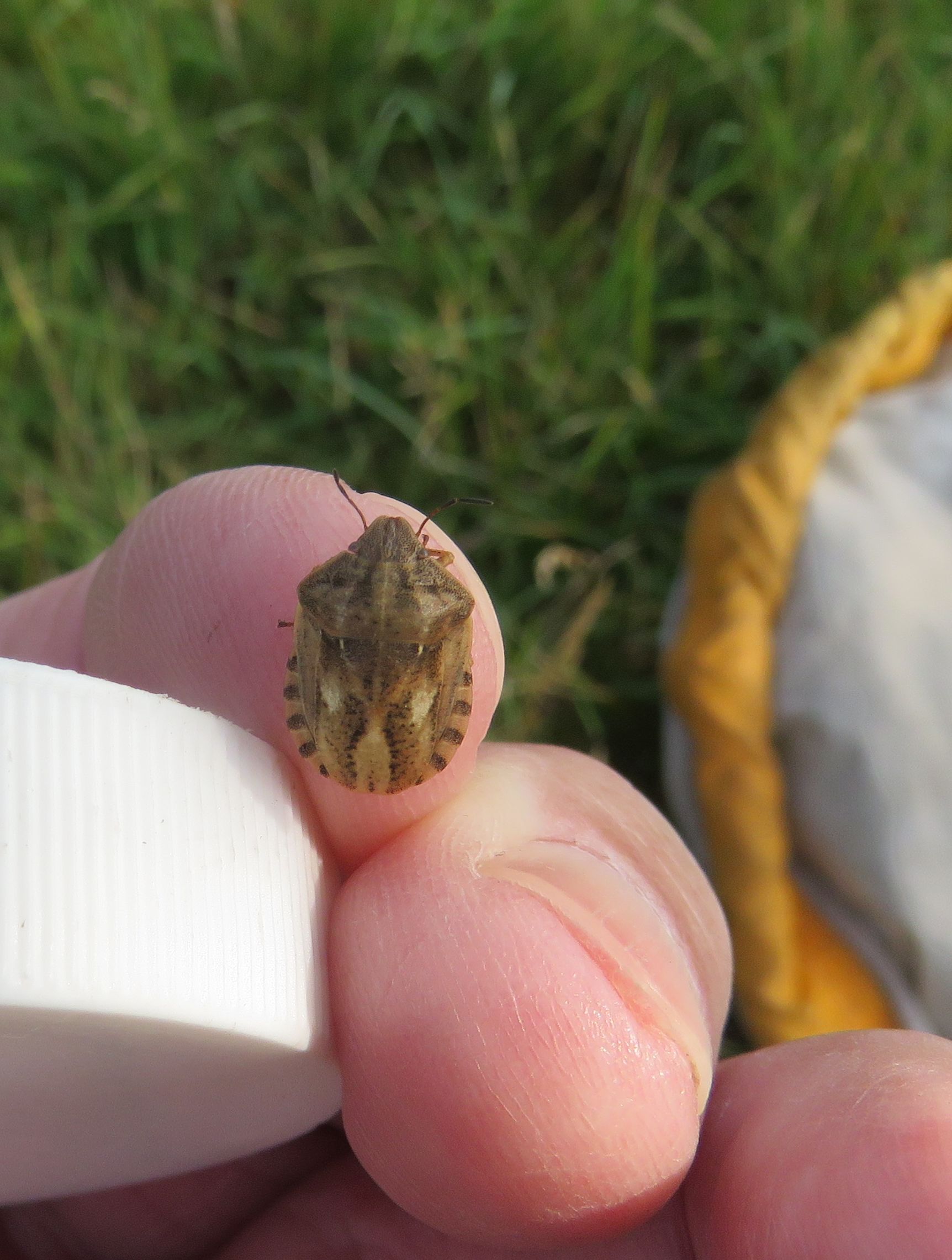 Whilst waiting for the Grandkids to turn up at Dinton Pastures for a play in the park I went out with the sweep net on the Old Golf Course in Area 10. Caught was a Tortoise Shieldbug Eurygaster testudinaria
Whilst waiting for the Grandkids to turn up at Dinton Pastures for a play in the park I went out with the sweep net on the Old Golf Course in Area 10. Caught was a Tortoise Shieldbug Eurygaster testudinaria 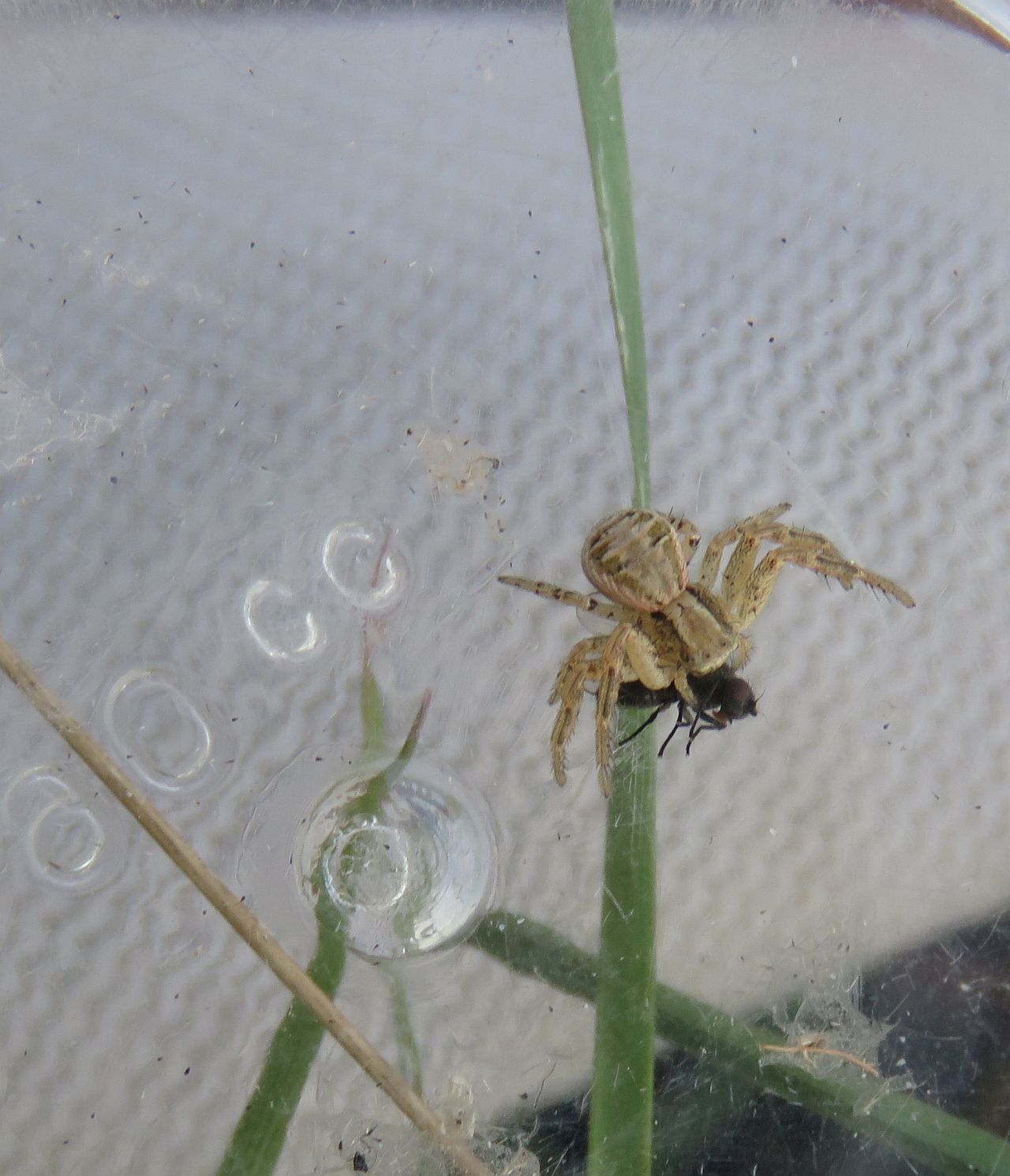 and a Spider that is believed to be Xysticus cristatus , however confirmation requires microscopic examination of the genitalia of adult specimens.
and a Spider that is believed to be Xysticus cristatus , however confirmation requires microscopic examination of the genitalia of adult specimens. 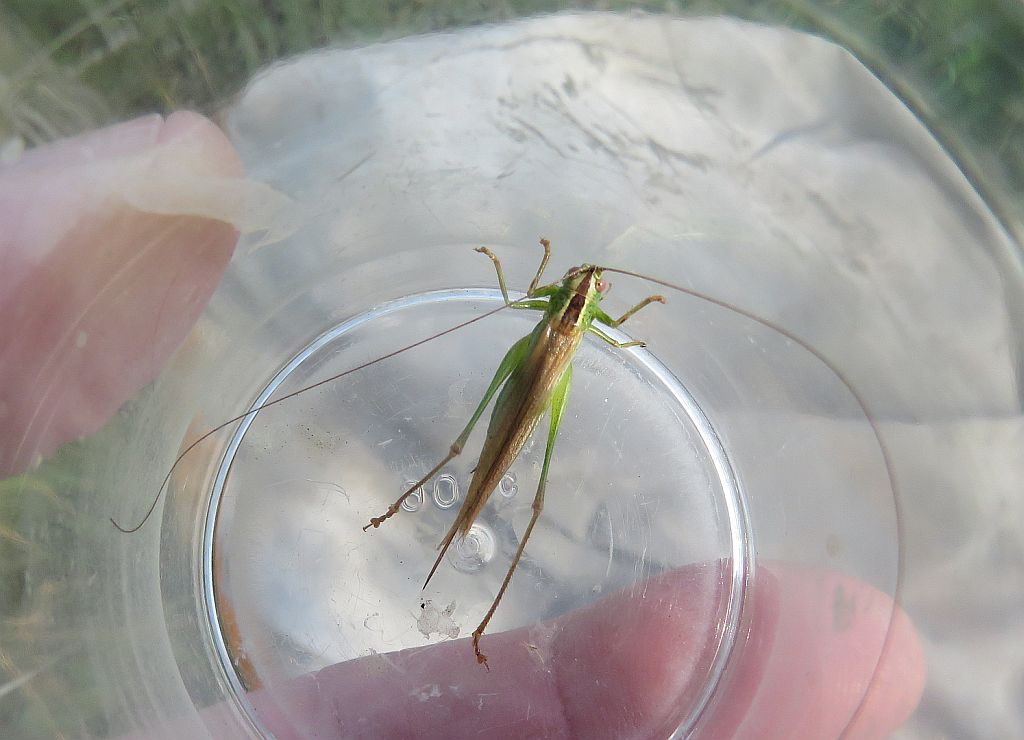 In the long grass was a Long Winged Cone-head Conocephalus fuscus This is a small Bush-cricket, named for the angled shape of its head.
In the long grass was a Long Winged Cone-head Conocephalus fuscus This is a small Bush-cricket, named for the angled shape of its head.
18/09/20
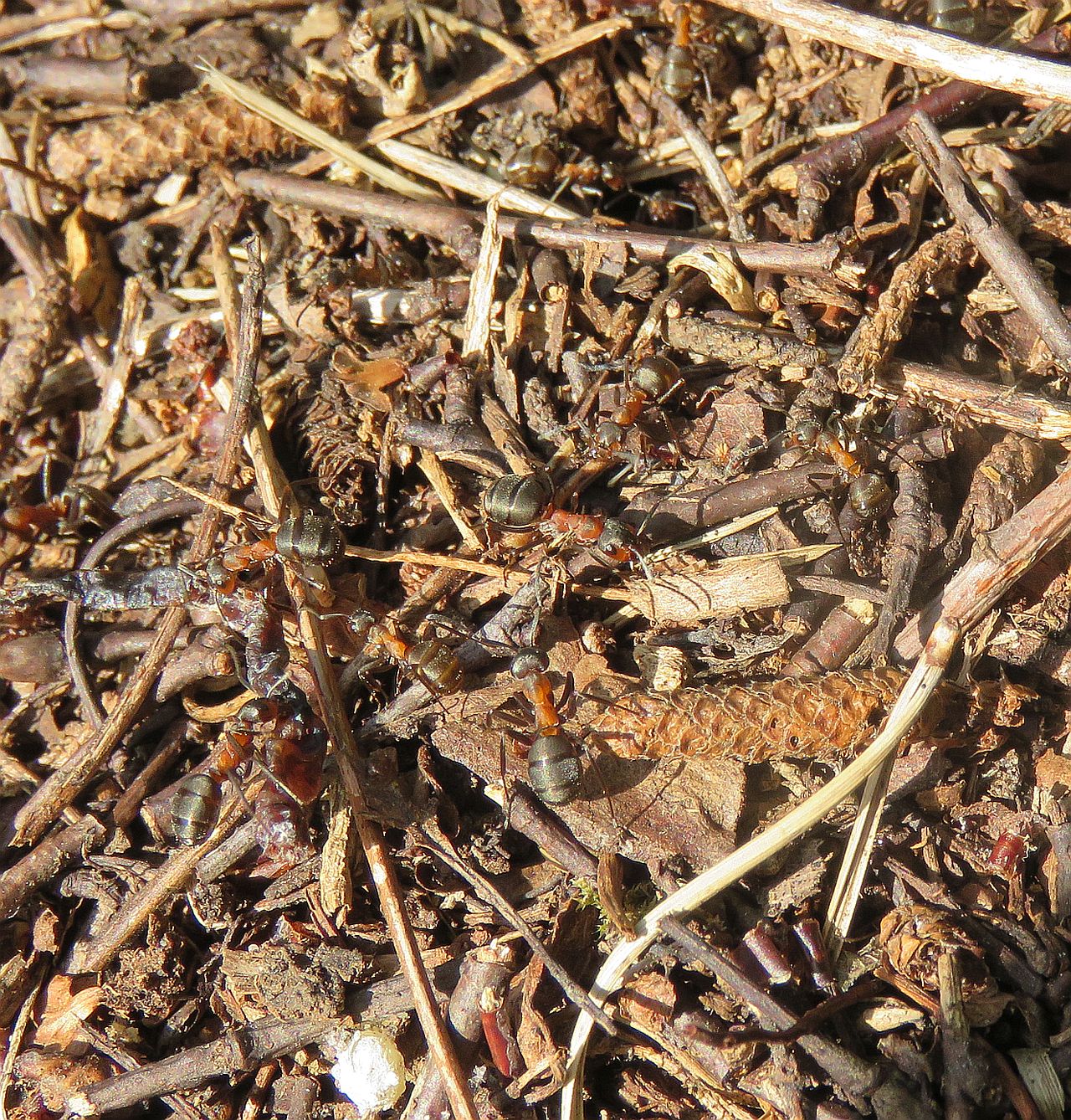 In amongst the Pine trees of Gorrick Wood in Area 1 were the ant hills of the Southern Wood Ant Formica rufa The Southern Wood Ant is an aggressive predator, equipped with large, biting jaws and the ability to spray formic acid in defence. It feeds on a wide variety of invertebrates, which the workers collect from the area surrounding their colony. Southern Wood Ants build large nests out of soil, twigs, leaves and pine needles. They can be found in open, sunny spots in both coniferous and broadleaved woodland, as well as on heathland and moorland. Colonies can sometimes number up to half a million individuals comprising non-reproducing female workers, a queen (or queens) that produces eggs, and males that mate with the queen.
In amongst the Pine trees of Gorrick Wood in Area 1 were the ant hills of the Southern Wood Ant Formica rufa The Southern Wood Ant is an aggressive predator, equipped with large, biting jaws and the ability to spray formic acid in defence. It feeds on a wide variety of invertebrates, which the workers collect from the area surrounding their colony. Southern Wood Ants build large nests out of soil, twigs, leaves and pine needles. They can be found in open, sunny spots in both coniferous and broadleaved woodland, as well as on heathland and moorland. Colonies can sometimes number up to half a million individuals comprising non-reproducing female workers, a queen (or queens) that produces eggs, and males that mate with the queen.  also along the rides in the sunshine were Common Darter Sympetrum striolatum flying out from low perches.
also along the rides in the sunshine were Common Darter Sympetrum striolatum flying out from low perches.
17/09/20
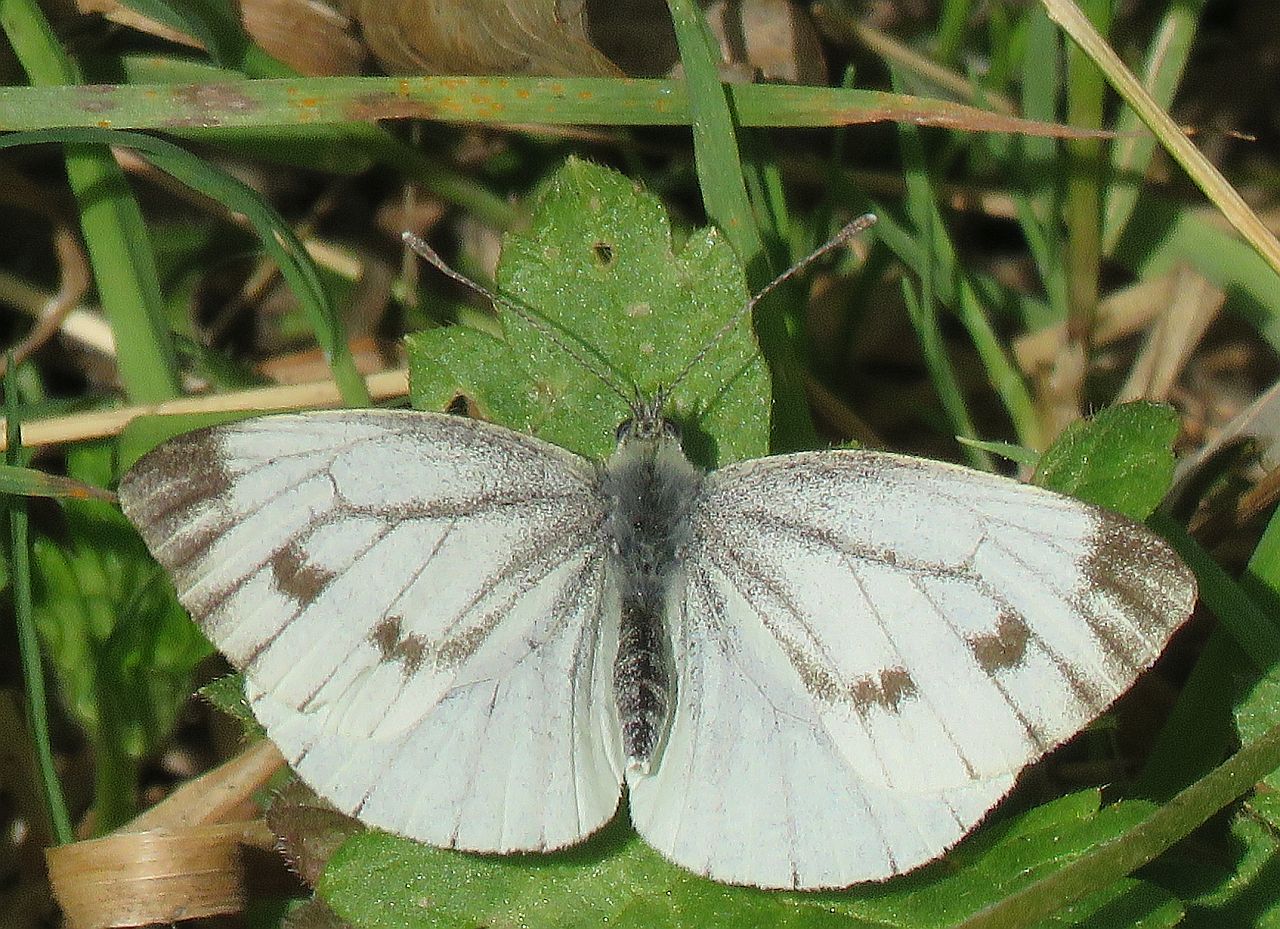 Lunchtime was spent in Area 10. Flying were Small White Pieris rapae and Speckled Wood Pararge aegeria.
Lunchtime was spent in Area 10. Flying were Small White Pieris rapae and Speckled Wood Pararge aegeria.
14/09/20
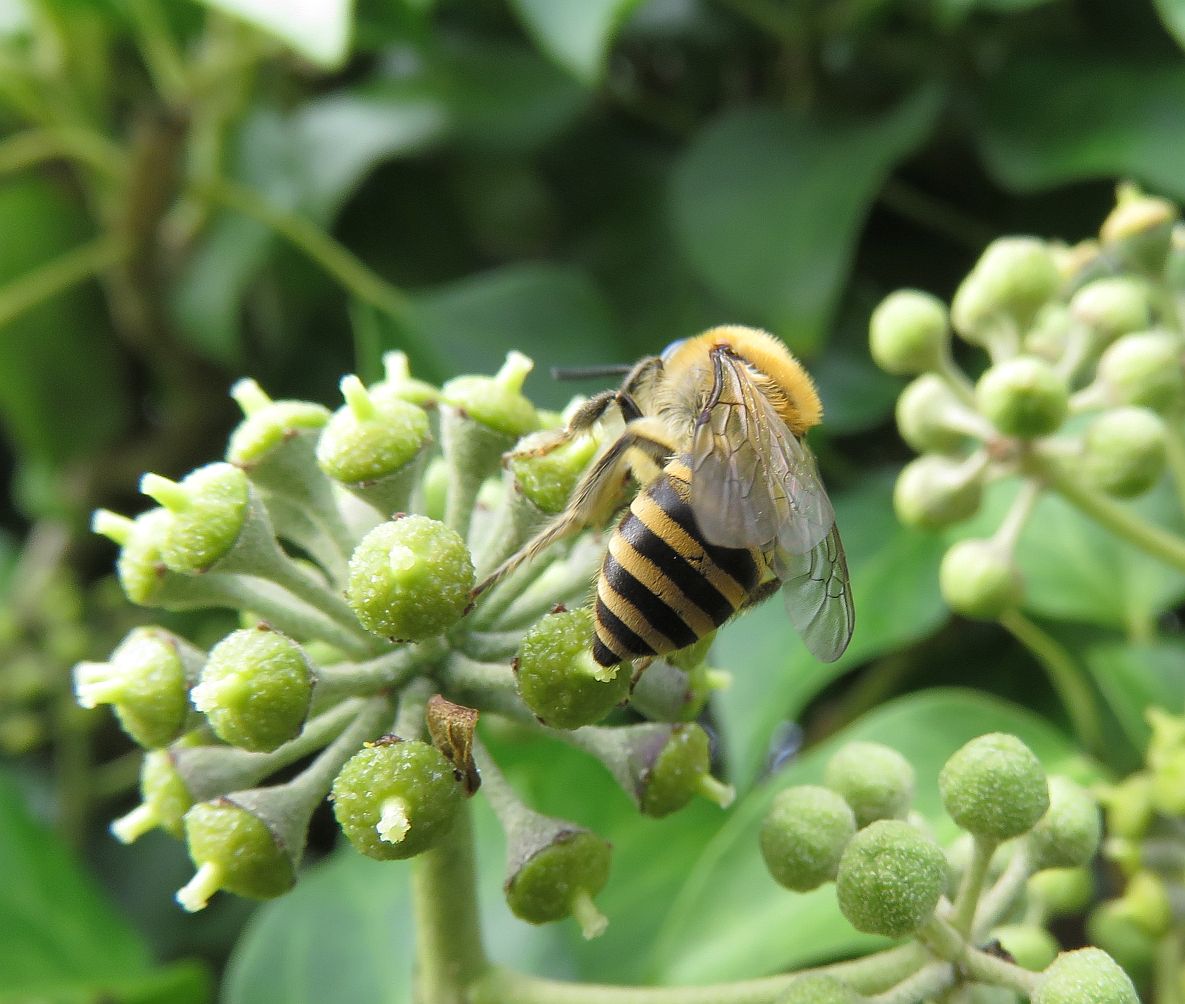 A brief lunchtime visit to Area 7 and feeding on the flowering Ivy at the roadside on Toutley Road were several Ivy Bee Vanessa atalanta . The ivy bee was first recorded in the UK in 2001. As suggested by its common name, Ivy is the main plant used by this bee for pollen.They time their emergence to fit in with the flowering period of this common plant, early September to November. Also frantically feeding were Common Wasp Vespula vulgaris and Honey bee Apis mellifera .
A brief lunchtime visit to Area 7 and feeding on the flowering Ivy at the roadside on Toutley Road were several Ivy Bee Vanessa atalanta . The ivy bee was first recorded in the UK in 2001. As suggested by its common name, Ivy is the main plant used by this bee for pollen.They time their emergence to fit in with the flowering period of this common plant, early September to November. Also frantically feeding were Common Wasp Vespula vulgaris and Honey bee Apis mellifera .  On the wing in Area 5 were Small Copper Lycaena phlaeas , Small White Pieris rapae and Red Admiral Vanessa atalanta . Flying around the pond was a male Migrant Hawker Aeshna mixta Dragonfly.
On the wing in Area 5 were Small Copper Lycaena phlaeas , Small White Pieris rapae and Red Admiral Vanessa atalanta . Flying around the pond was a male Migrant Hawker Aeshna mixta Dragonfly.
13/09/20
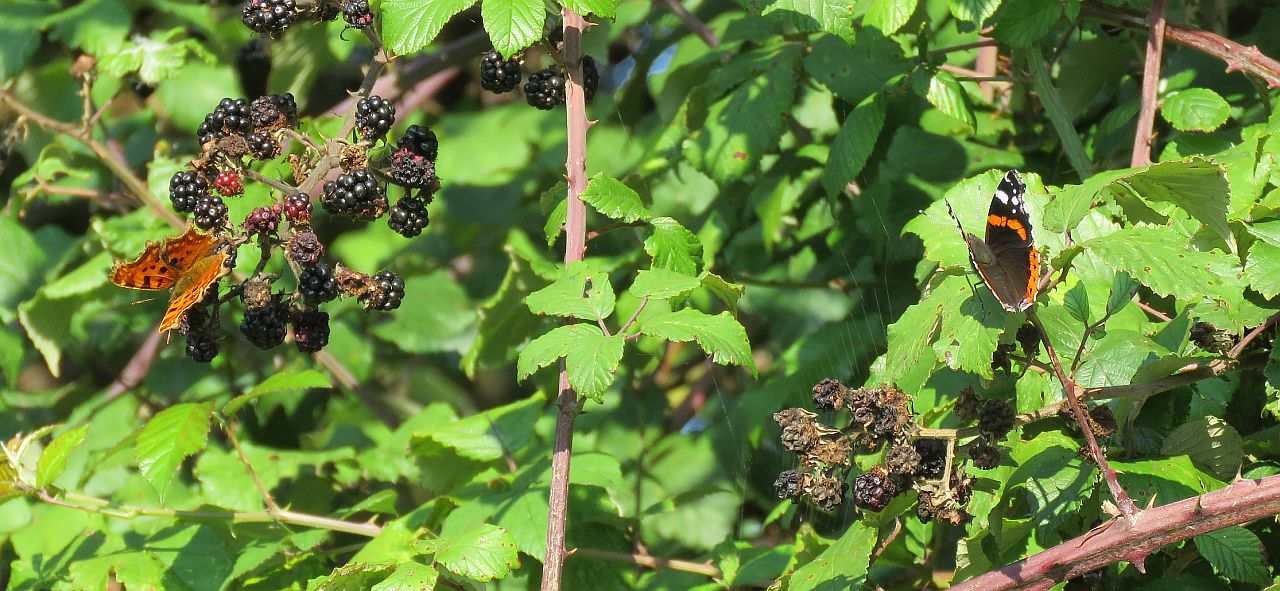 The morning was spent in Area 10 in and around the Car Park field off Sandford Lane. The sun was shining and I spent time watching a sunlit Bramble bush with good results. Feeding on the overripe Blackberries were Red Admiral Vanessa atalanta , Comma Polygonia c-album ,
The morning was spent in Area 10 in and around the Car Park field off Sandford Lane. The sun was shining and I spent time watching a sunlit Bramble bush with good results. Feeding on the overripe Blackberries were Red Admiral Vanessa atalanta , Comma Polygonia c-album ,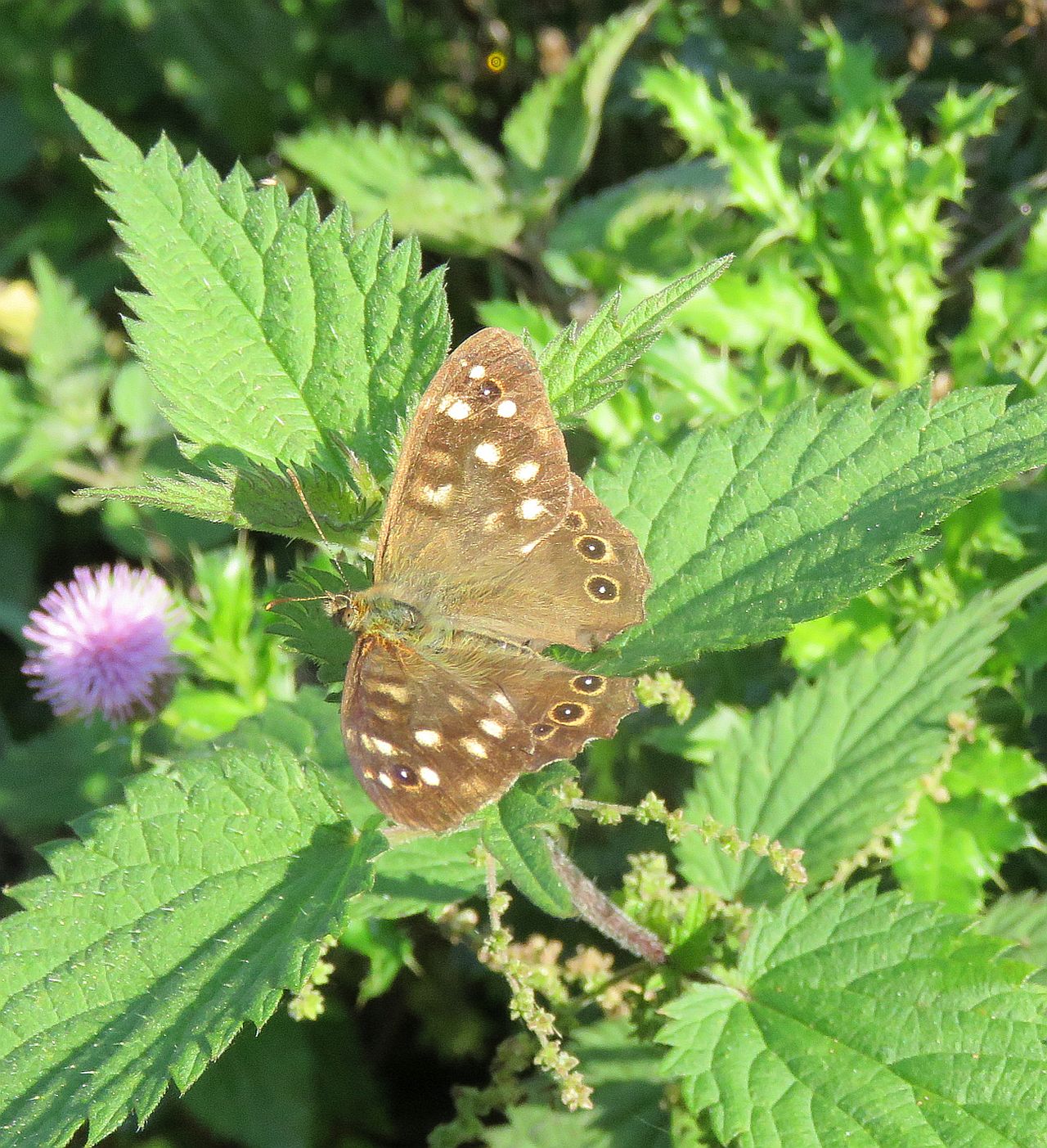 Small White Pieris rapae , Speckled Wood Pararge aegeria and nearby was a Small Copper Lycaena phlaeas on a Thistle, a total of 5 species of Butterfly . Also seen on the nearby vegetation was male and female
Small White Pieris rapae , Speckled Wood Pararge aegeria and nearby was a Small Copper Lycaena phlaeas on a Thistle, a total of 5 species of Butterfly . Also seen on the nearby vegetation was male and female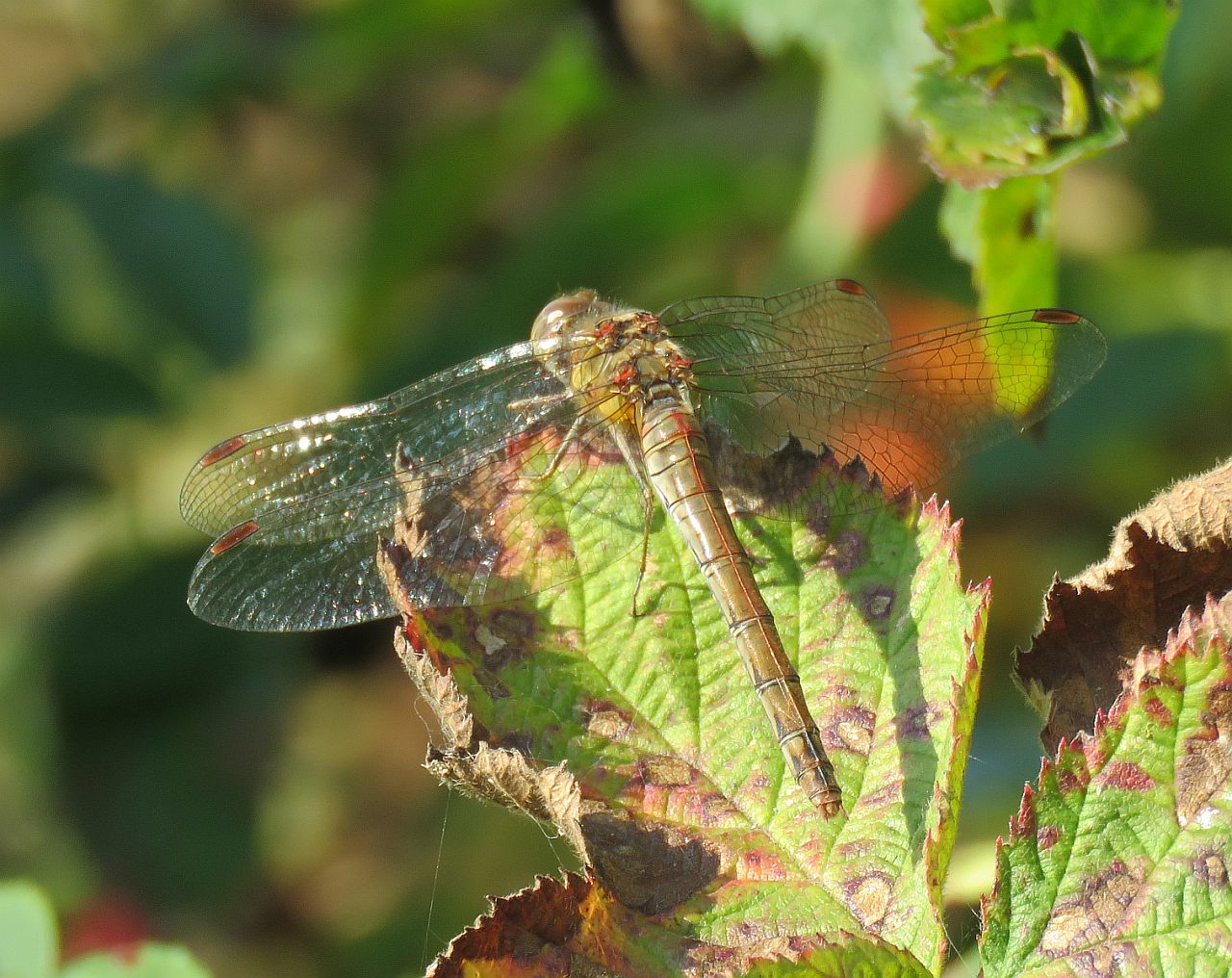 Common Darter Sympetrum striolatum This restless little species is the most widespread dragonfly in the lowlands. It flies late in the year, even into December.
Common Darter Sympetrum striolatum This restless little species is the most widespread dragonfly in the lowlands. It flies late in the year, even into December.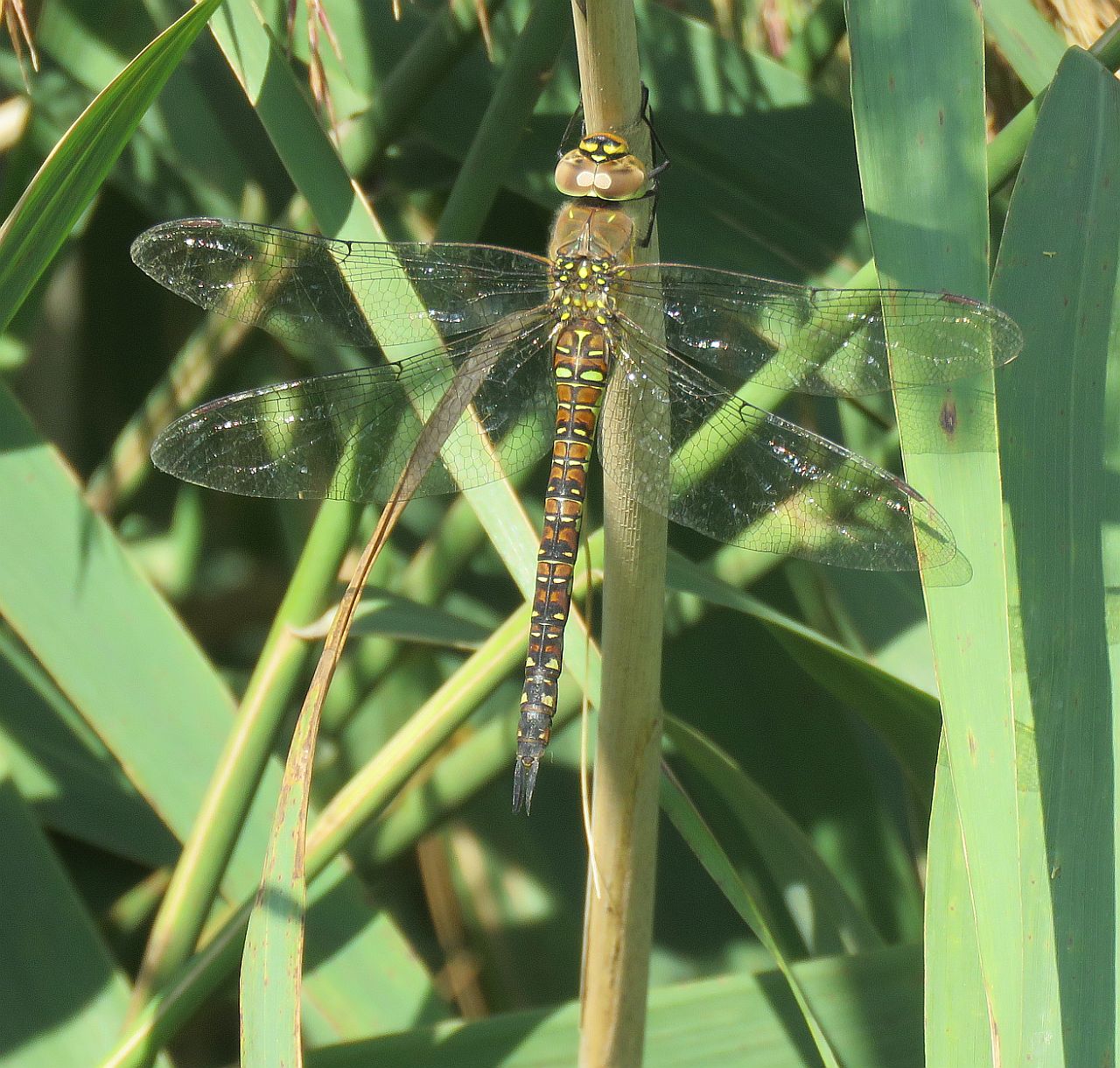 and male and female Migrant Hawker Aeshna mixta Dragonflies. Migrant Hawker is a relatively small "mosiac hawker" that flies well into autumn.
and male and female Migrant Hawker Aeshna mixta Dragonflies. Migrant Hawker is a relatively small "mosiac hawker" that flies well into autumn.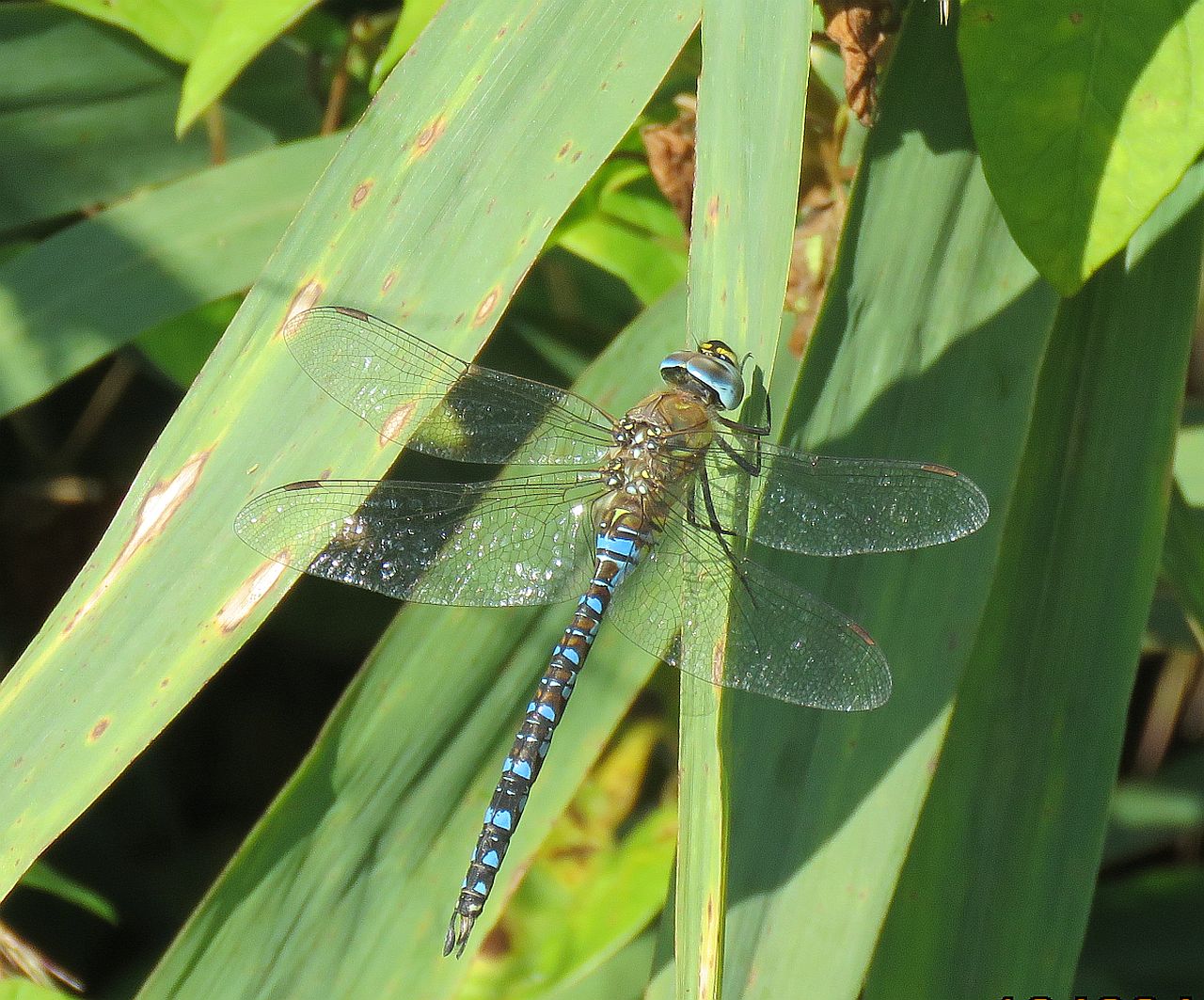 and a Common Blue Damselfly Enallagma cyathigerum
and a Common Blue Damselfly Enallagma cyathigerum
12/09/20
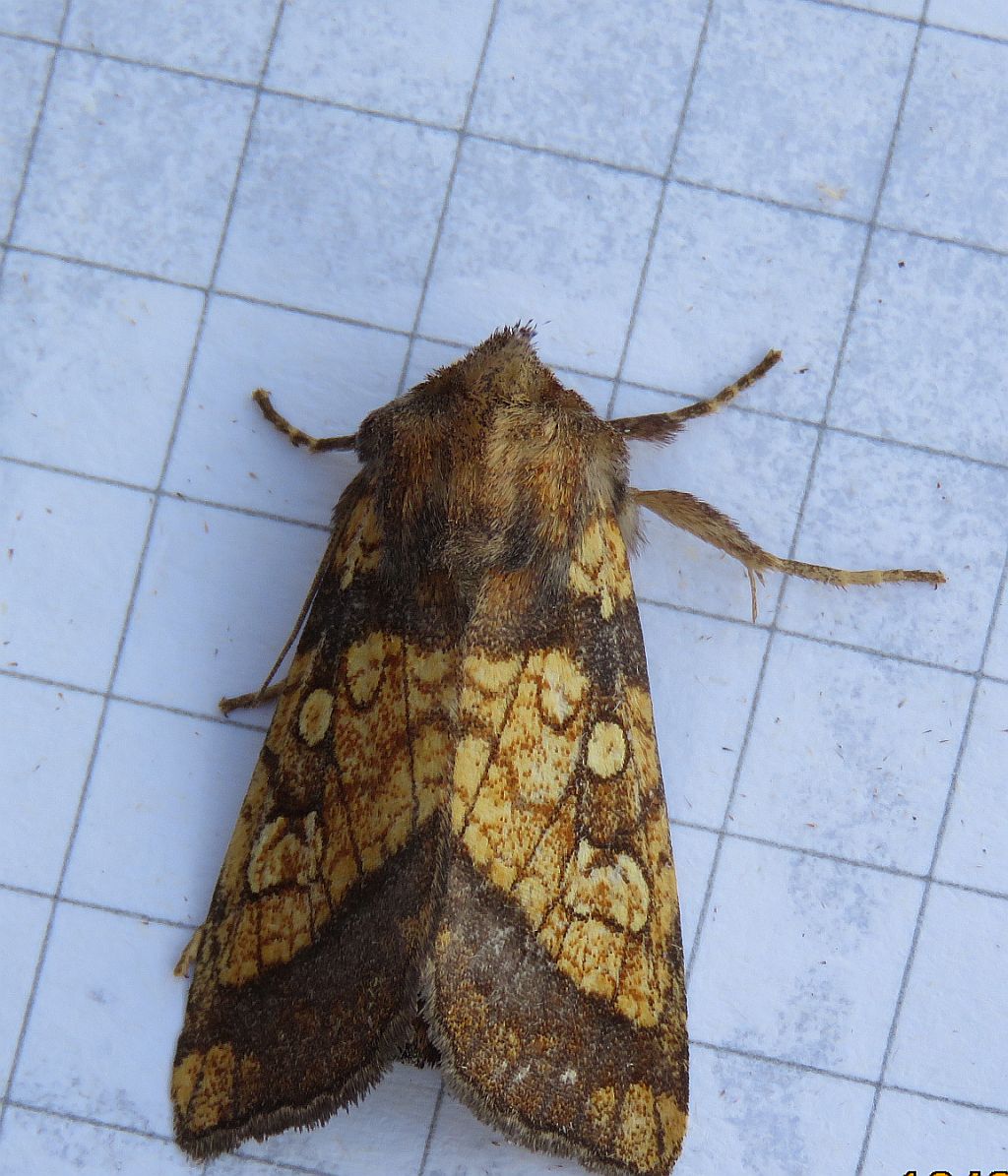 The Moth trap was out overnight and emptied this morning in Area 7A. 85 moths of 30 species were collected. Highlights were Frosted Orange Gortyna flavago , Angle Shades Phlogophora meticulosa
The Moth trap was out overnight and emptied this morning in Area 7A. 85 moths of 30 species were collected. Highlights were Frosted Orange Gortyna flavago , Angle Shades Phlogophora meticulosa and Brindled Green Dryobotodes eremita . Also caught were the Cranefly Tipula paludosa and Caddisflies Glyphotaelius pellucidus and Limnephilus lunatus . Following inspection and recording/photographing anything caught is released.
and Brindled Green Dryobotodes eremita . Also caught were the Cranefly Tipula paludosa and Caddisflies Glyphotaelius pellucidus and Limnephilus lunatus . Following inspection and recording/photographing anything caught is released..jpg) Found on the river bank in Area 5 was a Scarlet Lily Beetle Lilioceris lilii photographed by Paul Hopcraft.This species first reached Britain in the early 1900s.
Found on the river bank in Area 5 was a Scarlet Lily Beetle Lilioceris lilii photographed by Paul Hopcraft.This species first reached Britain in the early 1900s. .jpg) It first became established in the south of England but has now spread across the whole of the country.
It first became established in the south of England but has now spread across the whole of the country.
11/09/20
 A Wasp Beetle Clytus arietis was found on the curtains of an Area 5 house.The wasp beetle is a small, narrow-bodied longhorn beetle. The larvae live in warm, dry, dead wood, such as fence posts and dead branches, and particularly favour willow and birch. The wasp beetle lives up to its name by mimicking the common wasp in both colouration and in its behaviour, moving in a jerky fashion similar to a wasp's flight. This mimicry keeps it safe from predators, even though it is actually harmless.
A Wasp Beetle Clytus arietis was found on the curtains of an Area 5 house.The wasp beetle is a small, narrow-bodied longhorn beetle. The larvae live in warm, dry, dead wood, such as fence posts and dead branches, and particularly favour willow and birch. The wasp beetle lives up to its name by mimicking the common wasp in both colouration and in its behaviour, moving in a jerky fashion similar to a wasp's flight. This mimicry keeps it safe from predators, even though it is actually harmless.
10/09/20
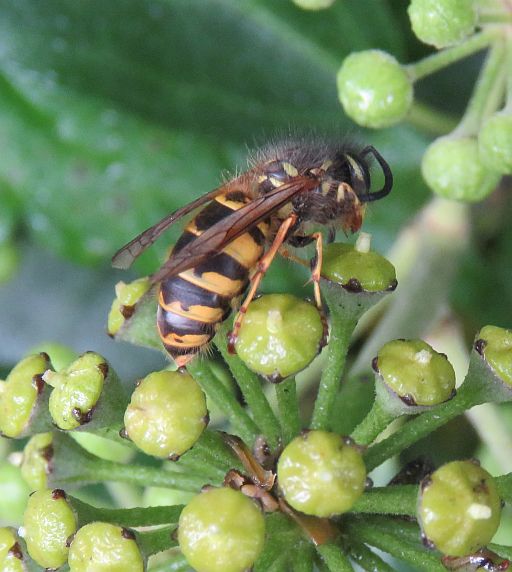 On a sunlit patch of Ivy in Area 1 at Ludgrove frequent visitors were Common Wasp Vespula vulgaris feeding on the flowers. Ivy is a late source of nectar at this time of year.
On a sunlit patch of Ivy in Area 1 at Ludgrove frequent visitors were Common Wasp Vespula vulgaris feeding on the flowers. Ivy is a late source of nectar at this time of year. Also enjoying the feast were Honey bee Apis mellifera .
Also enjoying the feast were Honey bee Apis mellifera .
09/09/20
 Another common Plant Gall is Poplar Spiral Gall caused by the Poplar Spiral Gall Aphid Pemphigus spyrothecae inducing this spiral gall on Lombardy Poplar.The spiral gall contains up to 30 wingless females.
Another common Plant Gall is Poplar Spiral Gall caused by the Poplar Spiral Gall Aphid Pemphigus spyrothecae inducing this spiral gall on Lombardy Poplar.The spiral gall contains up to 30 wingless females. 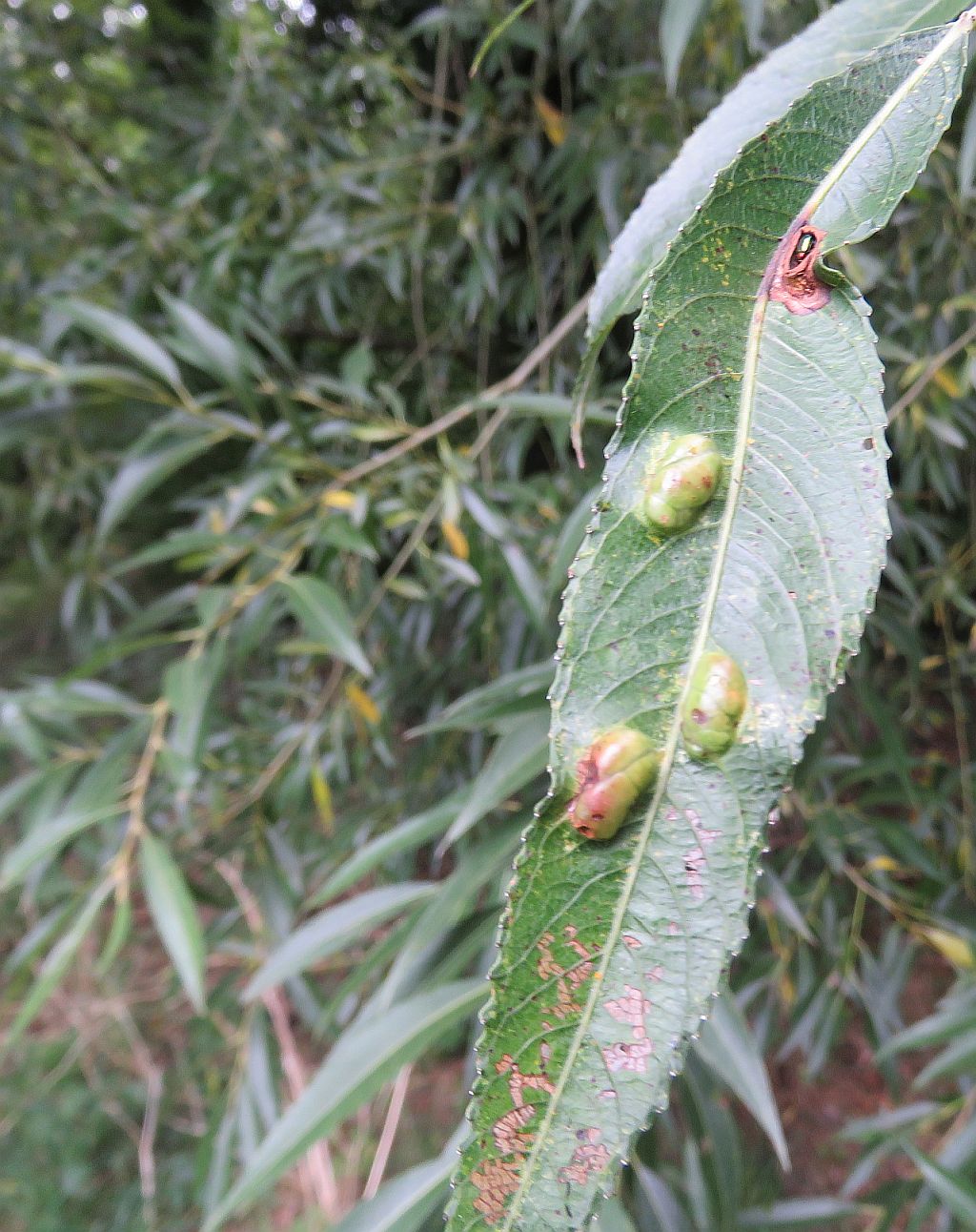 The Red Bean Gall is caused by the Sawfly Pontania proxima inducing its gall on Willow.The gall may be green, red or yellow, it is bean-shaped, smooth and emerges equally on both sides of the leaf. In mid summer the larva leaves the gall to drop to the ground where it pupates. A second brood emerges in late summer. Both were by Kingfisher Bridge in Area 4.
The Red Bean Gall is caused by the Sawfly Pontania proxima inducing its gall on Willow.The gall may be green, red or yellow, it is bean-shaped, smooth and emerges equally on both sides of the leaf. In mid summer the larva leaves the gall to drop to the ground where it pupates. A second brood emerges in late summer. Both were by Kingfisher Bridge in Area 4.
08/09/20
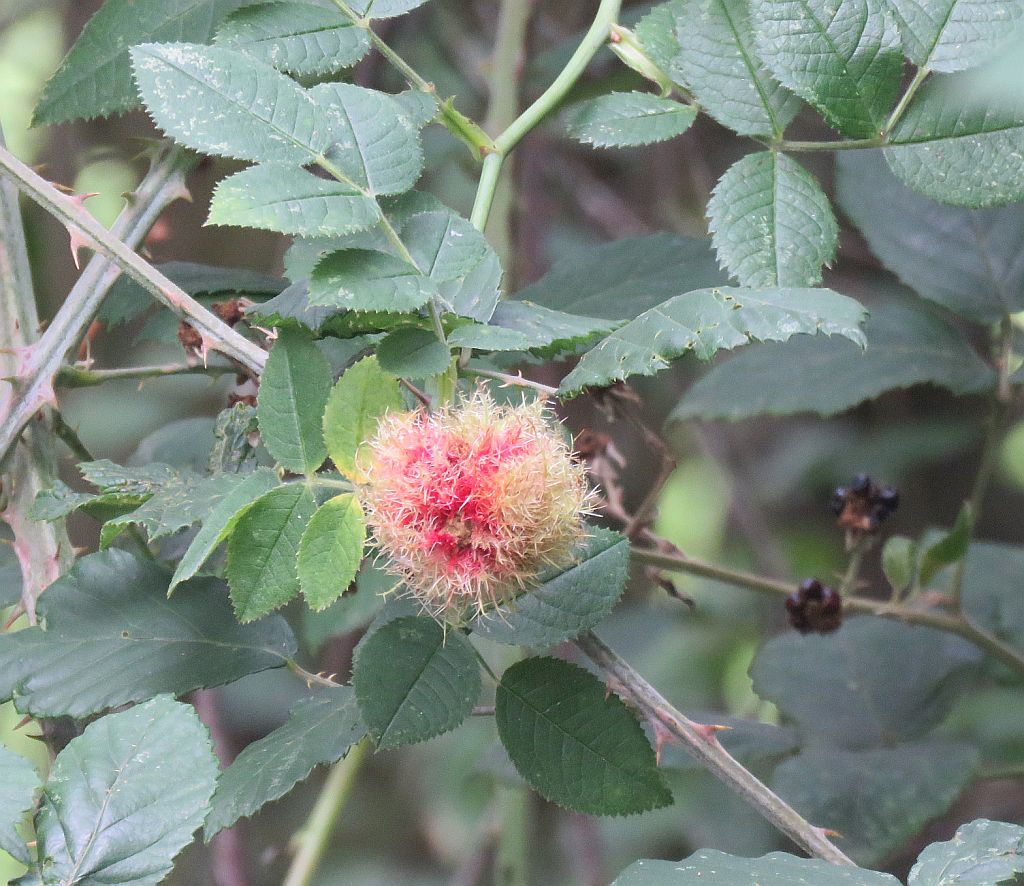 At this time of year with Insect numbers declining a young mans fancy turns to Plant Galls. These are abnormal growths that are induced by the presence of another organism. A well known one is Robins Pin Cushion caused by the Gall Wasp Diplolepis rosae laying its eggs in the bud of a Dog Rose in Spring. This one was in Area 5.
At this time of year with Insect numbers declining a young mans fancy turns to Plant Galls. These are abnormal growths that are induced by the presence of another organism. A well known one is Robins Pin Cushion caused by the Gall Wasp Diplolepis rosae laying its eggs in the bud of a Dog Rose in Spring. This one was in Area 5.
07/09/20
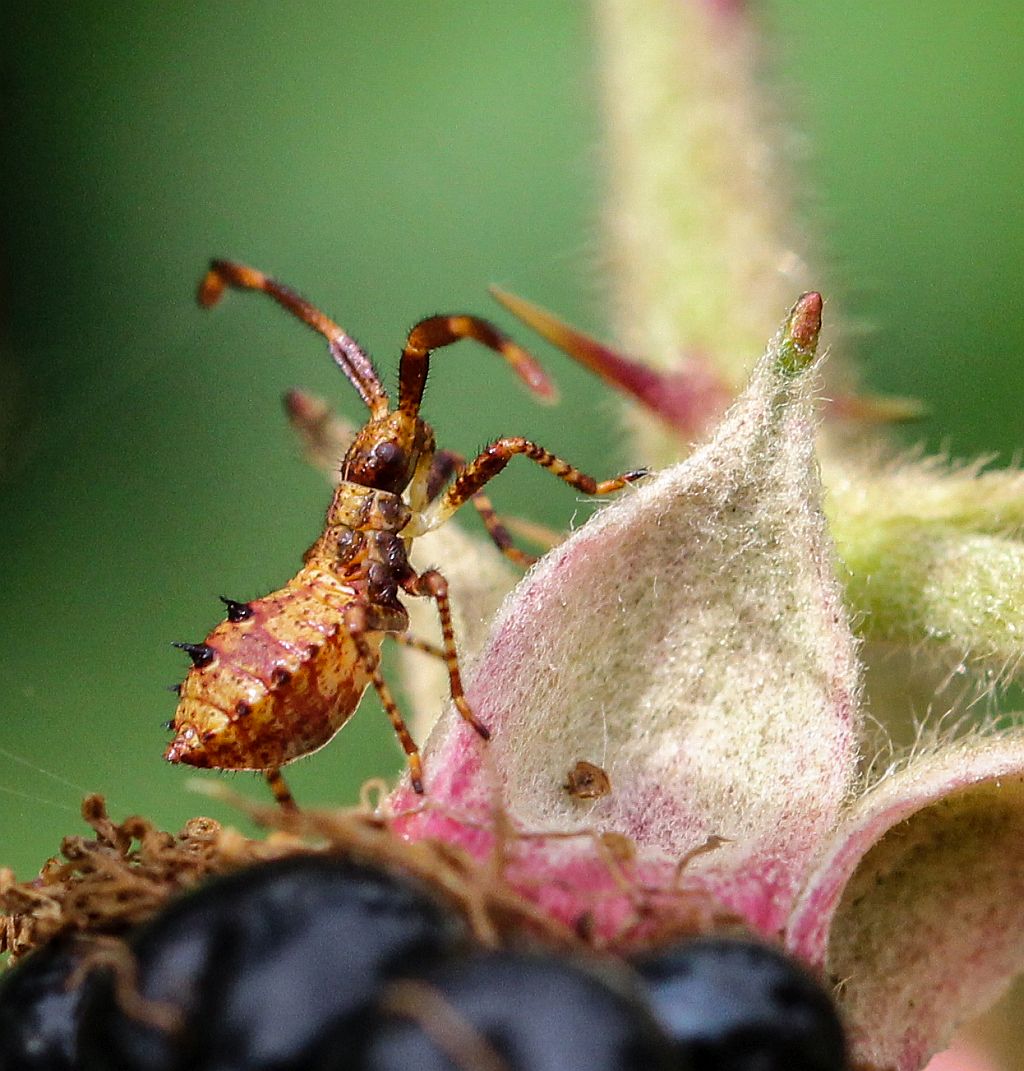 Captured by Paul Hopcraft on Brambles in Area 4 was an early instar nymph of a Dock Bug Coreus marginatus . An instar is a developmental stage of arthropods, such as insects, between each moult (ecdysis), until sexual maturity is reached. Arthropods must shed the exoskeleton in order to grow or assume a new form.
Captured by Paul Hopcraft on Brambles in Area 4 was an early instar nymph of a Dock Bug Coreus marginatus . An instar is a developmental stage of arthropods, such as insects, between each moult (ecdysis), until sexual maturity is reached. Arthropods must shed the exoskeleton in order to grow or assume a new form.
06/09/20
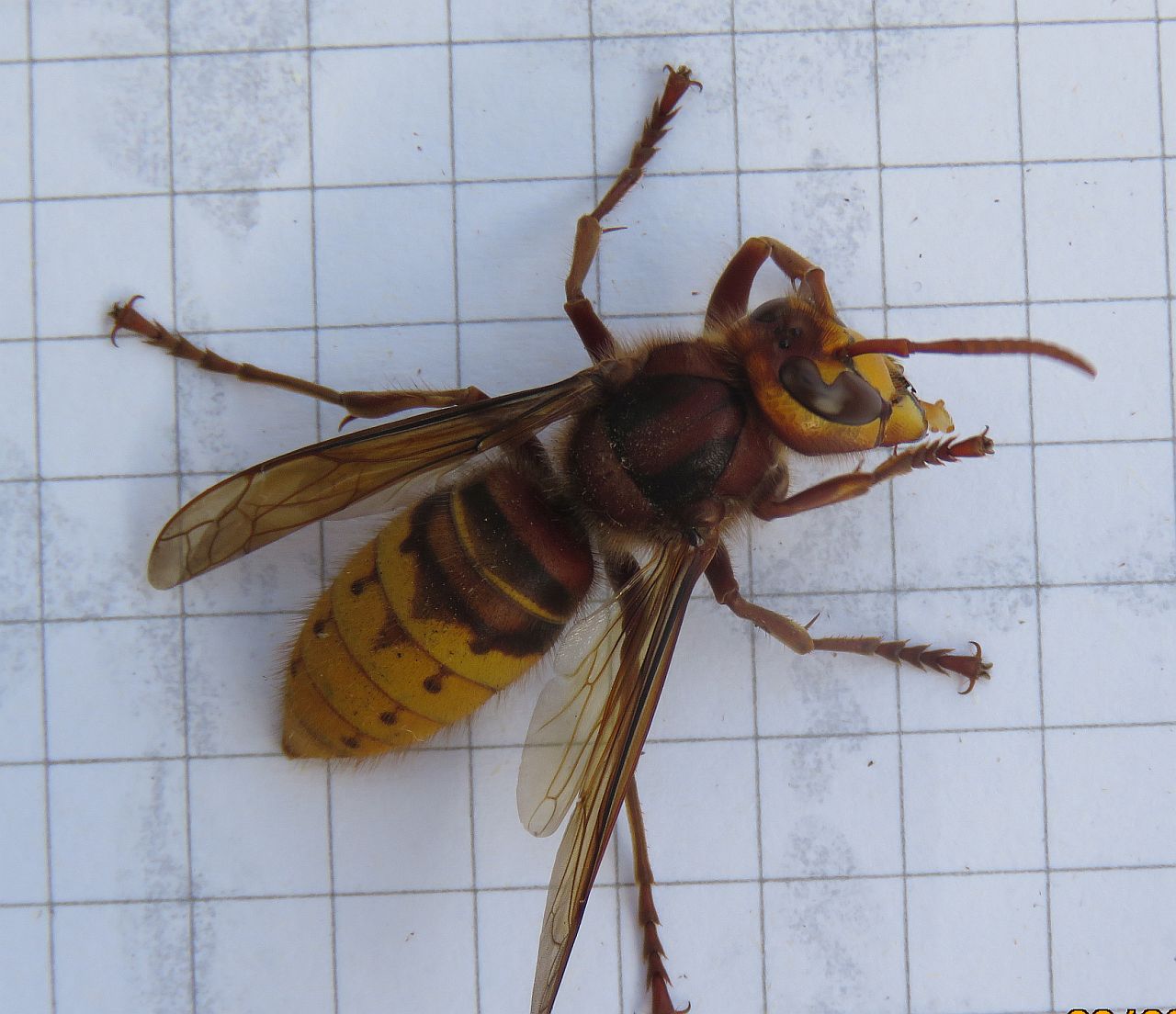 With a bit more time at the weekend the Moth trap was out overnight in Area 7A. When the catch was inspected this morning apart from 40 moths of 22 species there was a Hornet Vespa crabro . Moth highlights were Chinese Character Cilix glaucata
With a bit more time at the weekend the Moth trap was out overnight in Area 7A. When the catch was inspected this morning apart from 40 moths of 22 species there was a Hornet Vespa crabro . Moth highlights were Chinese Character Cilix glaucata  and Bright-line Brown eye Lacanobia oleracea .Following inspection and recording/photographing anything caught is released.
and Bright-line Brown eye Lacanobia oleracea .Following inspection and recording/photographing anything caught is released.
05/09/20
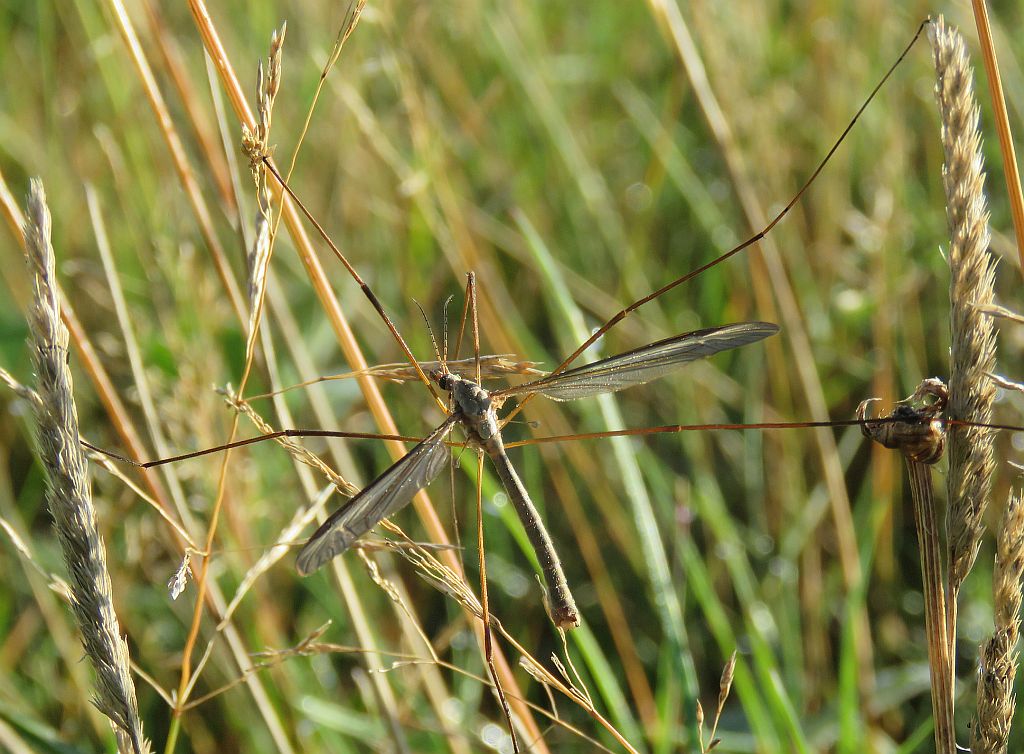 Now is the time to see adult crane flies or daddy longlegs they emerge during late summer to mate and lay their eggs into lawns and flower beds. There are over 300 crane fly or daddy long-legs species in the UK. Several Tipula paludosa were seen in Area 7A.
Now is the time to see adult crane flies or daddy longlegs they emerge during late summer to mate and lay their eggs into lawns and flower beds. There are over 300 crane fly or daddy long-legs species in the UK. Several Tipula paludosa were seen in Area 7A.
04/09/20
 A flying trip to Area 10 this morning on the Old Golf Course produced a Small Copper Pararge aegeria butterfly on the wing. Lunchtime was spent in Area 5 watching a sunlit Blackberry bush. Among its many visitors was a male Common Darter Sympetrum striolatum dragonfly resting on leaves,
A flying trip to Area 10 this morning on the Old Golf Course produced a Small Copper Pararge aegeria butterfly on the wing. Lunchtime was spent in Area 5 watching a sunlit Blackberry bush. Among its many visitors was a male Common Darter Sympetrum striolatum dragonfly resting on leaves,  a Dock Bug Coreus marginatus a Common Green Shieldbug Palomena prasina , 2 Small White Pararge aegeria butterfly. Flies are fairly abundant at this time of the year, among the more easily identifiable are Flesh Fly Amobia signata , Bluebottle Protophormia Terraenovae. and Greenbottle Neomyia cornicina all of which like to bask in the sun.
a Dock Bug Coreus marginatus a Common Green Shieldbug Palomena prasina , 2 Small White Pararge aegeria butterfly. Flies are fairly abundant at this time of the year, among the more easily identifiable are Flesh Fly Amobia signata , Bluebottle Protophormia Terraenovae. and Greenbottle Neomyia cornicina all of which like to bask in the sun.
03/09/20
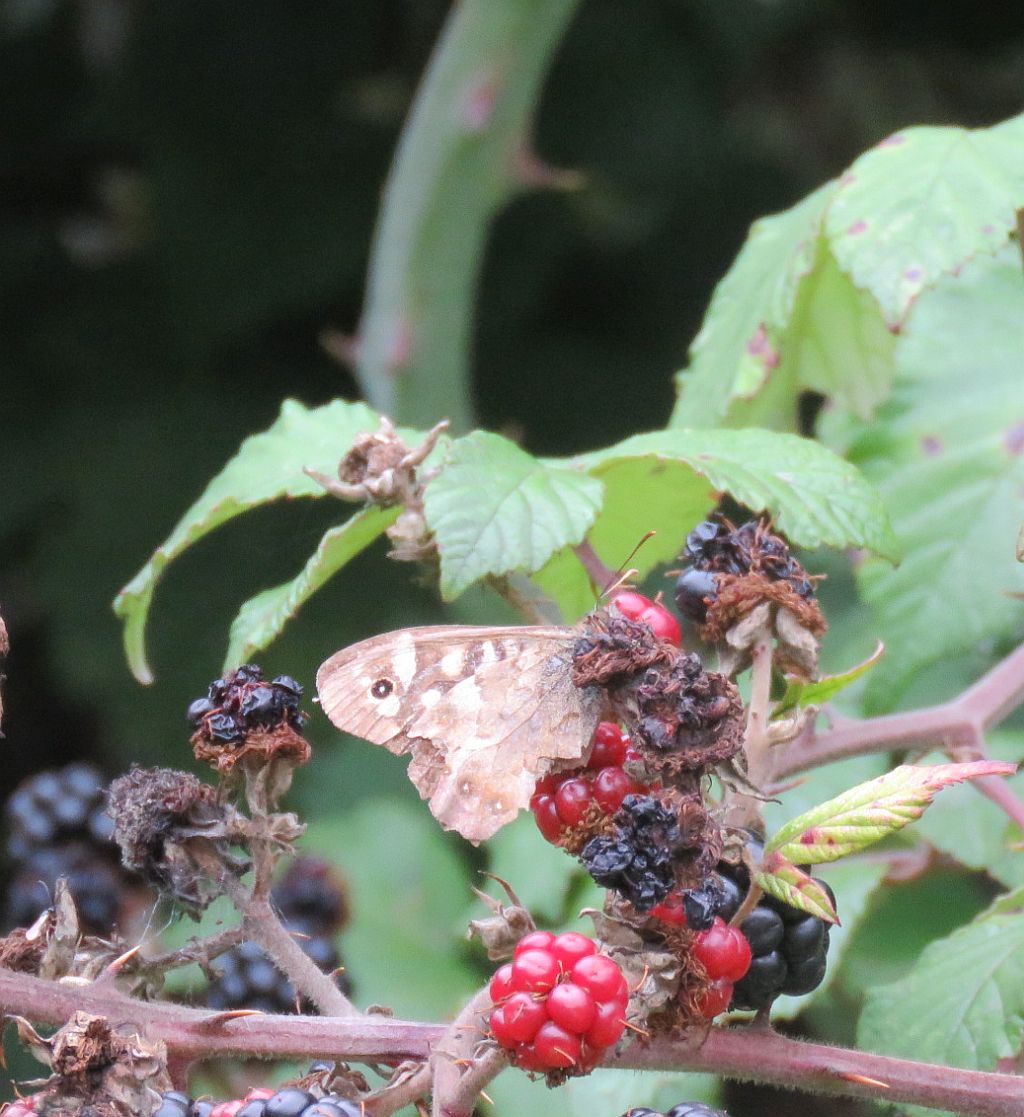 Enjoying over ripe Blackberries in the Area 10 Car Park Field was a battered and worn Speckled Wood Pararge aegeria .
Enjoying over ripe Blackberries in the Area 10 Car Park Field was a battered and worn Speckled Wood Pararge aegeria .


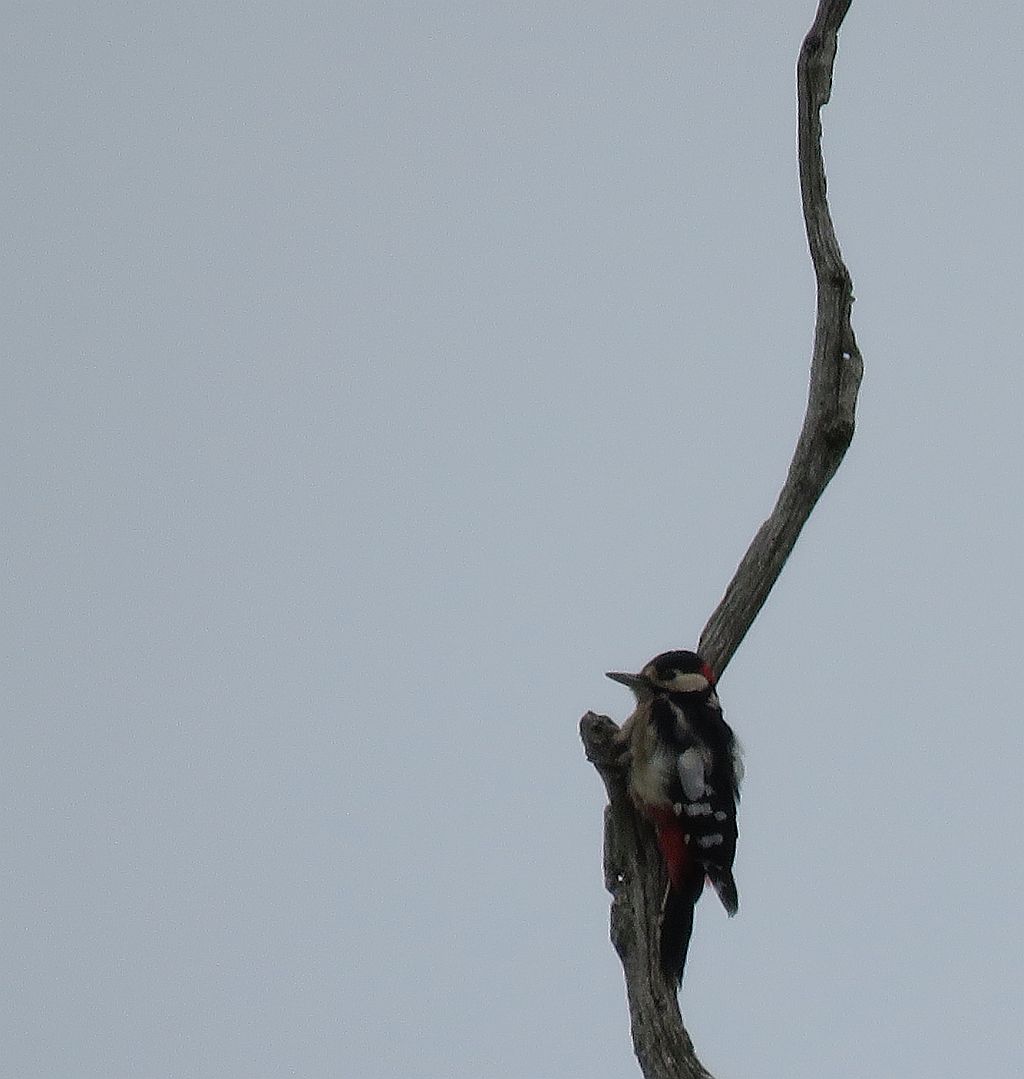

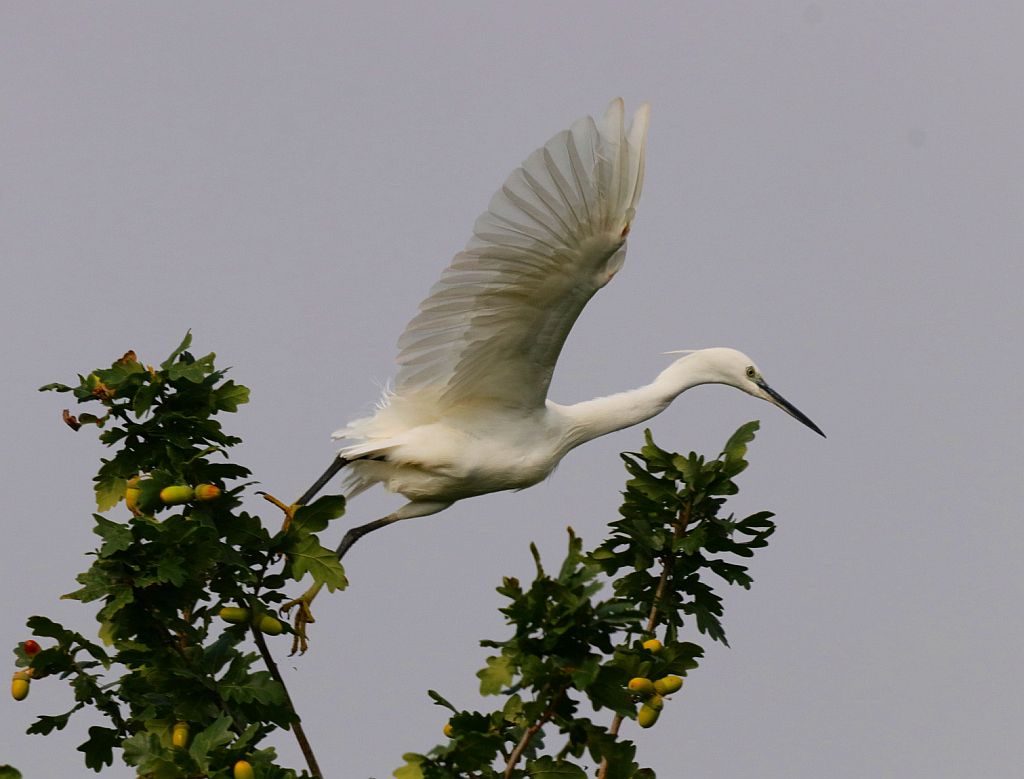
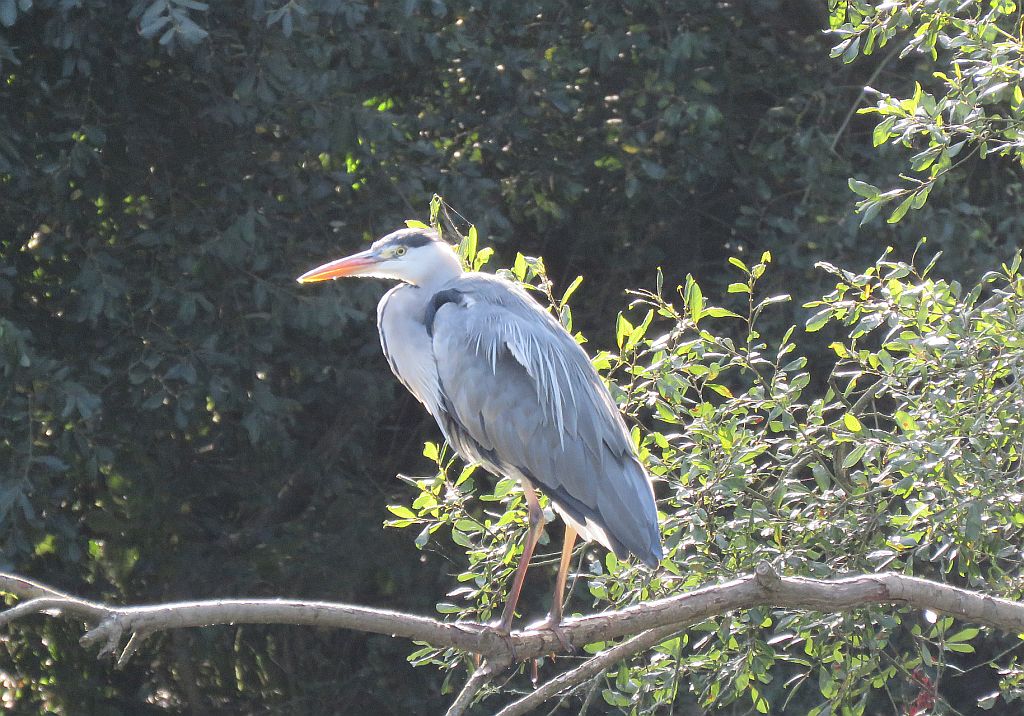

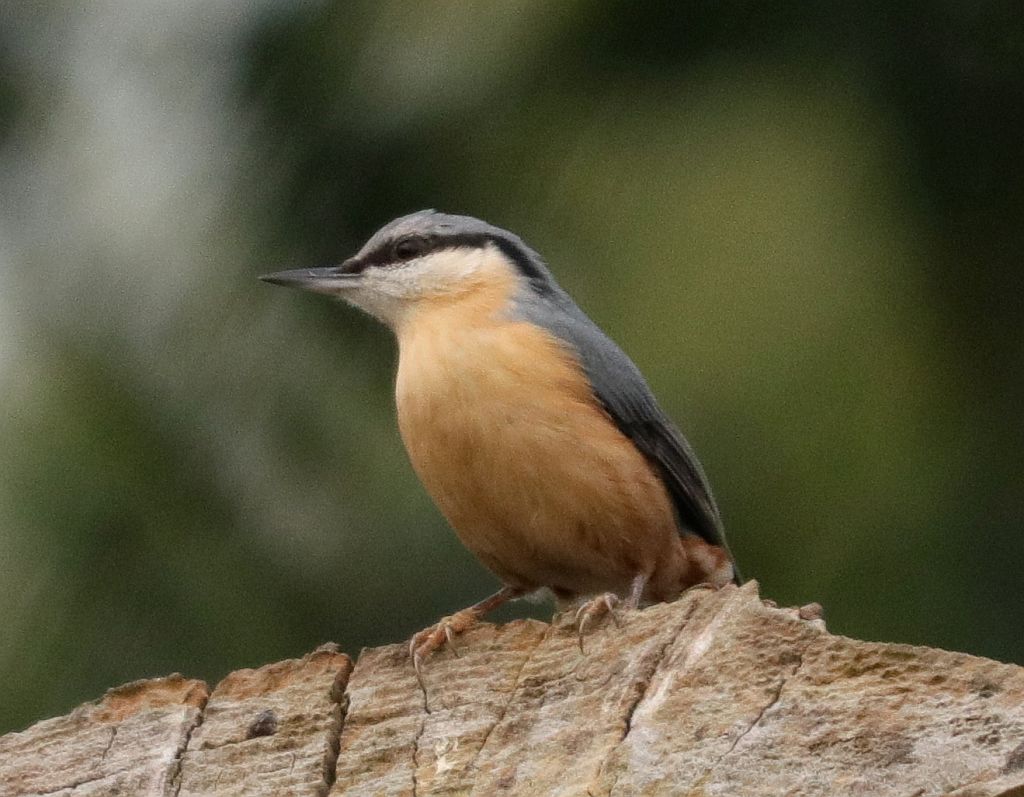
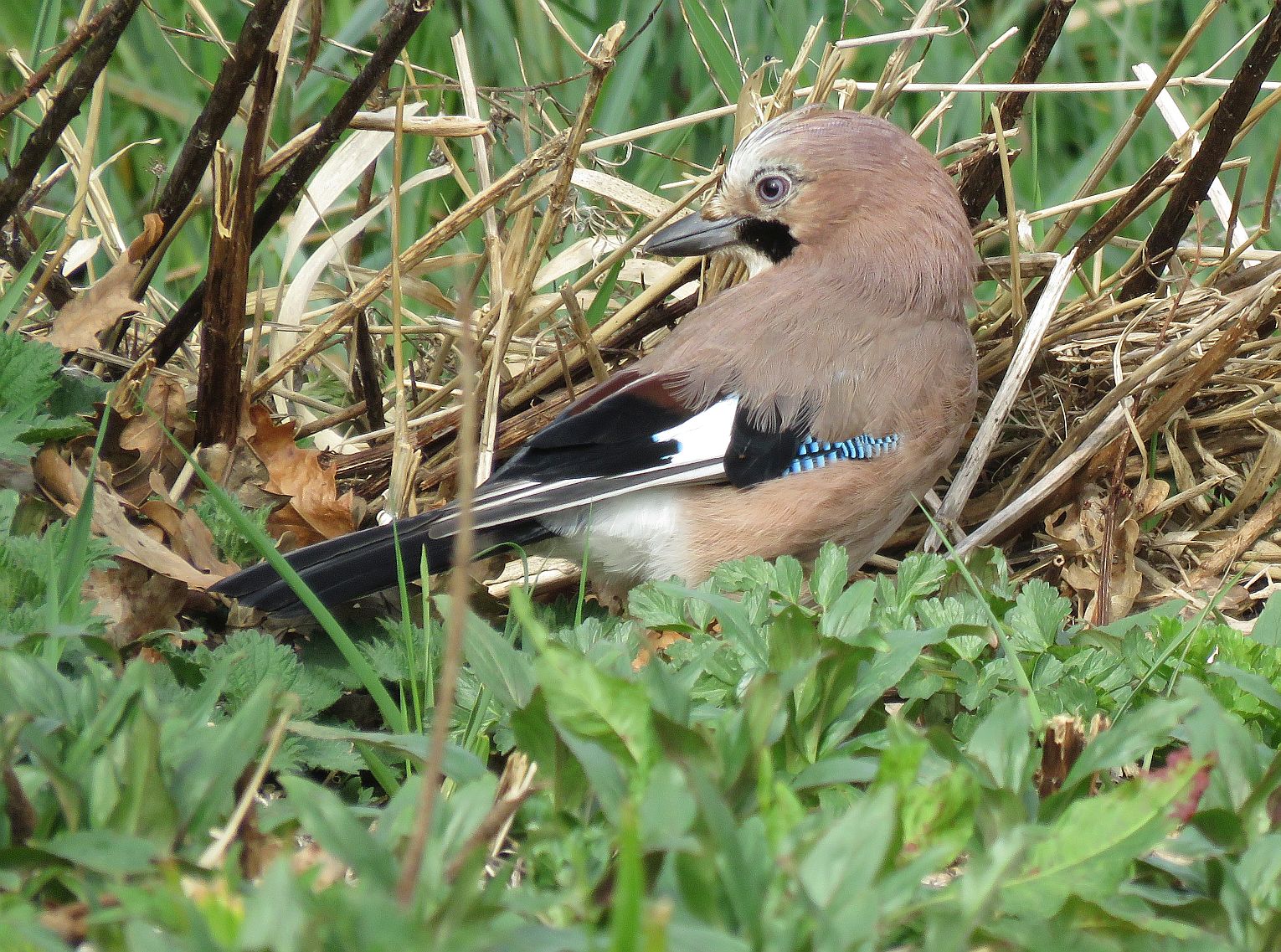
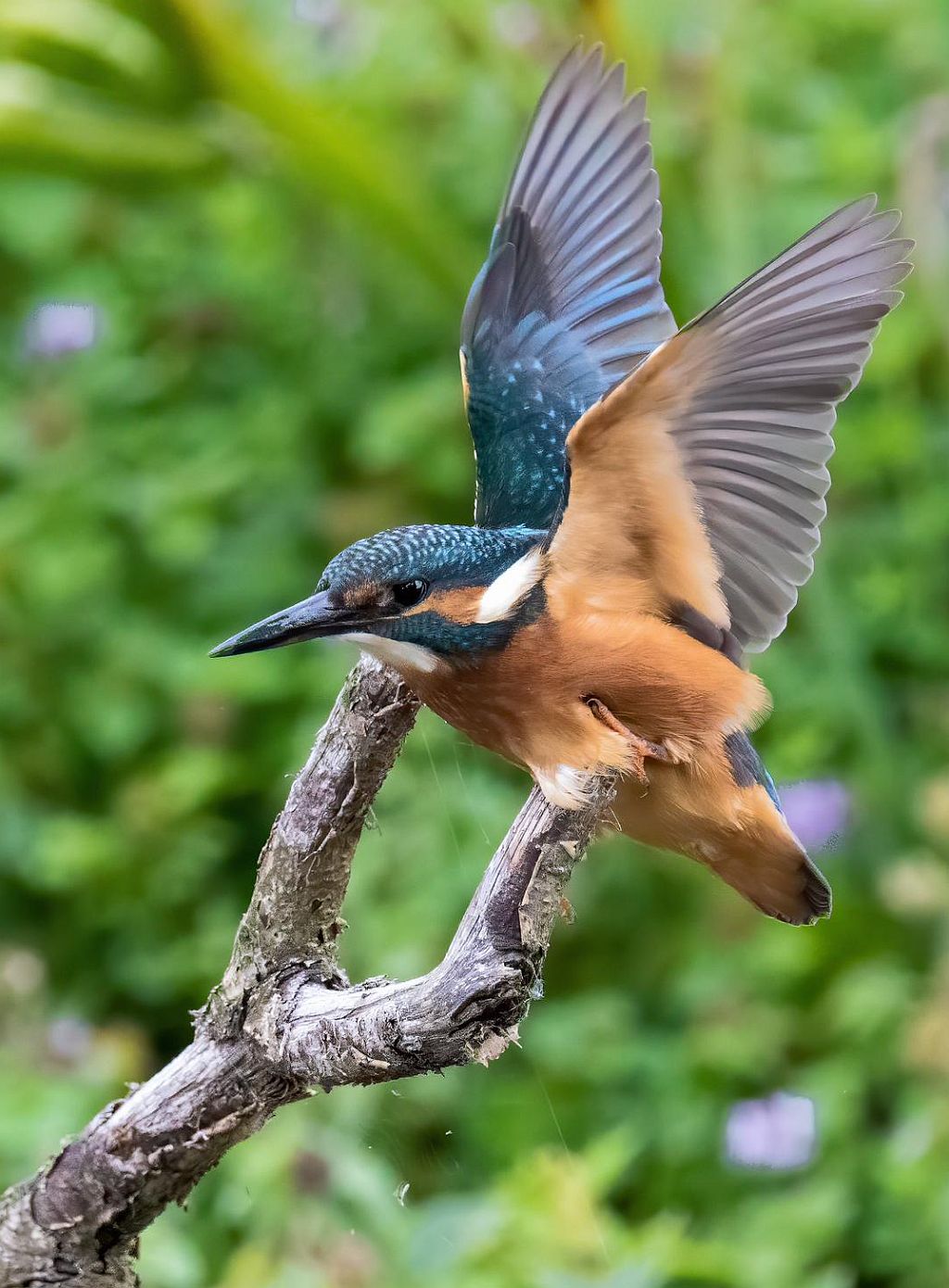

























.jpg)
.jpg)













